| |
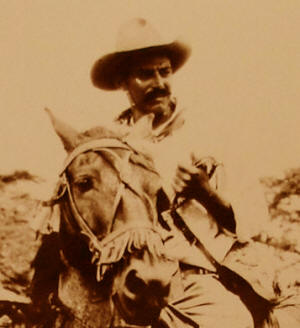
|
 |
 |
 |
 |
| |
TO 31 MARCH
1929 |
1-24 APRIL
1929 |
25
APR-JULY 1929 |
PHOTOS |
This is the
first of FOUR MAIN pages
housing materials relating
to the
fascinating case of the Voluntarios,
a counterinsurgency experiment
that the US Marines undertook from January to
June 1929 to augment the native
Guardia's limited military capabilities in the
fight against Sandino & the EDSN.
(Photo: Liberal & Voluntario General Juan
Escamilla in Jinotega, 1929)
The
Voluntarios experiment failed utterly.
How do we
interpret that failure? The
documents presented in these pages suggest a
number of broader questions, themes, and
conclusions. By my reading, the scheme not
only failed but backfired, in multiple ways.
Senior US military leaders (Gen. Feland, Col.
Dunlap) created the Voluntarios at a particular
moment (early 1929), mainly for political
reasons. The goal was to put Nicaraguans
"in the field" and at least appear to be trying
to "exterminate bandits" alongside the Marines,
in order to legitimate the intervention in the
eyes of the populace. As Col. Dunlap put
it in a personal letter to Col. Berkeley
(Jan. 29),
"If this force never has a [military] contact it
is going to exercise a decided influence for
good in that the natives will see that
Nicaraguan authority is interested in
suppressing the bandits."
Just-inaugurated President Moncada's interests
dovetailed with Dunlap & Feland's. Moncada
had election promises to keep. Appointing
his old Liberal generals — Escamilla, Flores,
Caldera, and many others — he repaid his
political allies, filled a gap in Guardia
recruitment, and unleashed the violent
persecution of Conservatives as well as the
EDSN.
Among the elite, the Voluntarios re-inflamed
Liberal-Conservative conflicts
from the just-ended Civil War. Among
campesinos, the extreme violence inflicted by
Voluntario & Marine Corps troops inflamed
popular sentiments against the state & toward
Sandino, especially in the Western Segovias &
the Jinotega highlands, and especially around
Yalí. More broadly, the whole idea behind
the Voluntarios ran directly against the grain
of the larger, structural shift being engineered
by the State Department: the
centralization of violence-making capacities in
the institution of the Guardia Nacional.
For all these reasons the whole experiment
lasted only five months (January-May 1929, more
or less, with some remnants continuing
afterward). A short-term political fix,
the scheme quickly backfired, and was ended by
new Commanding General Dion Williams. In
the bigger picture, the
failure of the Voluntarios mainly
speaks to the success of the national state in
rapidly monopolizing violence-making capacities
in the institution of the Guardia Nacional.
It's an exceptionally illuminating
flash-in-the-pan set of ironies & unintended
consequences that speaks to broader issues of
state formation, popular nationalism, civil war,
empire formation, strategies of
counterinsurgency, and more.
"There
should be no place in the scheme for an orphan
organization," wrote the
perspicacious Marine Corps Captain George F.
Stockes on 8 April 1929 in his recommendation that
the Voluntarios, with whom he'd worked
closely for the past several months, be
disbanded. "The Volunteer force is
partisan. . . .The Guardia is non-political.
In a country where people are so violent in
their political views, this is of extreme
importance. . . . the Guardia Nacional should
constitute the armed forces of the Nicaraguan
Government."
Stockes perceived, accurately, that the
fragmented, decentralized, personalized nature of the
violence practiced by the Voluntarios
was fundamentally incompatible with the central
state's rapid monopolization of the legitimate
authority to exercise violence-making capacities
across the national territory. Yet the
pressures that led to the creation of the
Voluntarios did not go away, leading to a series
of related experiments after the official
termination of this one in May 1929. And the
Guardia did not remain "non-political" for long.
Indeed, it never was, but the Marines tried hard
to make it so.
The first three Voluntario
pages house 152 documents in 193 JPEG files,
organized
chronologically, that relate to the
creation, activities & disbandment of the
Voluntarios. Around 60 newspaper accounts, mainly
from La Tribuna in Managua, complement the "official"
record of the Marines & Guardia.
Page 1 begins in
April 1928 with a handful of
context-setting documents and takes the story
to the end of March 1929.
Page 2
takes us from April 1-24, 1929.
Page 3
carries the story into May, June & July, with
the disbandment of the Voluntarios and the
ripple effects of the terror they wrought across
rural Jinotega, as seen in the battalion medical
officer's 12 July 1929 report on the "refugee"
camps outside San Sebastian de Yalí. The
official record amply substantiates press
allegations of atrocities committed during this
prolonged "Pacification" campaign (e.g.,
"Escamilla y el Pueblo de Yalí," La Tribuna,
July 24). Marine-Guardia documents in
these pages are scans or digital photos of
photocopies of the originals, most from Record
Group 127 of the US National Archives, with
archival locations usually indicated on each
document. The pages of La Tribuna
were photographed in the Library of Congress.
Page 4
(located in
PHOTO-DOCS > USMC-GN > PAGE 7: VOLUNTARIOS)
houses all known photographs of Voluntario jefes
& troops (13 in all).
Several other pages offer
additional materials on the Voluntarios:
•
Additional Patrol & Combat Reports
involving the Voluntarios are housed in
PC-DOCS for the first half
of 1929.
•
The Bush Trial & Statement
of EDSN General Manuel María Girón Ruano,
executed in early March 1929 by Hanneken &
Escamilla after a kangaroo court convicted him
of "banditry," are housed in the
TOP 100,
PAGE 27.
•
The Joint Operations of
Marines & Voluntarios in the
Western Segovias & Honduran borderlands are
housed in both the
PC-DOCS for the first half
of 1929, and in the
TOP 100, PAGE 33.
The collection begins about nine months
before the formal constitution of the
Voluntarios in January 1929. A handful of
representative documents
provide context & set the stage
for what followed: property-owners'
appeals to the state
for protection of their properties — the
dissolution of any practical distinction between
Sandinista rebels and Segoviano civilians, as
perceived by the architects & practitioners of the
counterinsurgency campaign — the fiscal
incapacities of the national state to pay for
the war against Sandino and for a standing army big
enough to maintain the level of "order &
stability" that the USA deemed necessary — and
the Marines' efforts to
enlist the services of civilian militias
in order to make up
for the military deficiencies of the Guardia
Nacional.
Interpretive or explanatory
remarks accompany some transcriptions.
Grateful acknowledgments
are extended to my friend Linda M. Kinney for
her help with the transcriptions.
|
|
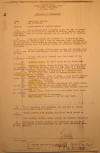
|
April 9, 1928.
"Apprehension of Sandino Agents,"
Intelligence Memorandum, Major Hans Schmidt,
Managua.
"1. It is desired that
a special effort be made to arrest persons
who have been actively engaged in helping
Sandino and his followers. This to include
persons who are reputed to be 'playing both
sides'. ¶ 2. When such persons are arrested
it is requested that this office be notified
with a view to securing their confinement in
the National Penitentiary at Managua, with
general charges being preferred against them
for aiding Sandino in rebellion against his
government. ¶ 3. Names of agents will be
sent as they are secured. They will be sent
to all intelligence officers for further
distribution by them. ¶ 4. At this time it
is desired that the arrest of the following
be secured: ¶ (a) Hipolito Agasse, who has a
store at San Marcos and Telpaneca. ¶ (b)
Guadalupe Rivera, owner of Santa Cruz. Has
also lived in Jinotega. His house has been
used for some time as a base for forwarding
supplies, mail and military stores of all
descriptions. ¶ (c) Gregorio Espinosa, a
caretaker of a ranch at the northern exit of
the Guale Pass, owned by Señora Pastora
Blandon v. de Mairena of Jinotega. (d)
Nicolas Jarquin, Juez de Mesta. A very
active Sandino agent. Jefe Politico in
Jinotega may know more about this person. ¶ (e) P. Palina A., Guiguili. ¶ (f) Andres
Garcia, Pantasma. ¶ (g) Bartolo Villagra.
Letter originated from Santa Helena. Do not
know where this is. Letter was dated March
1, 1928. (h) Salvador Gutierrez.
Communicates with Rivera. Believed to be in
Jinotega area. (i) Domingo Perez, believed
to be from Santa Cruz, Guale or Pantasma. ¶ (j) Francisco Salgado of Matosano. (k) Jose
Morales, believed to be from Las Vegas. ¶ 5.
It is requested that Calderon, now confined
at Pueblo Nuevo be held until further
orders. ¶ 6. Señora Pastora y de Mayrena
Blandon [Pastora Blandon v. de Mairena] of
Guale should be watched. ¶ 7. When sending
reports please include any available
evidence. ¶ 8. Commanding officer Eastern
Area arresting any agents of Sandino will
secure their confinement in the most
convenient place in that locality."
Notes & Comments:
This and the following documents included to
illustrate several broader themes that
continued under the Voluntarios: the Marine-Guardia's expanding
practice of identifying specific individuals
for detention or surveillance, and because
one such suspect is Pastora Blandón v. de
Mairena, who figures prominently in the
documents to follow.
|
|
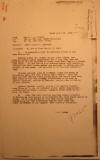
|
April 12, 1928.
"Jefe Politico, Jinotega," Major K. E.
Rockey, Guale.
"Enclosure: (a) Letter
from Capt G. T. Hall. ¶ 1. In
connection with the attached letter it has
been determined: ¶ Valonio Gadea
(a), father of one Andre Gadeas, has been an
active bandit sympathizer for a long time,
carried pack mules of food supplies to Yacca
Pucca [Yucapuca] when Sandino's forces were
there. His son has been in correspondence
with Sandino's officers and both Gadeas
father and son went in hiding upon our
arrival in this area. Son reported to be now
with Sandino's army. ¶ Nicolas
Jarquin, Juez de la Mesta, Guale has acted
as collecting agent for stores being sent to
Sandino. This had been reported several
times during March and should have been well
known by the Jefe proving conclusively to be
true by letters captured, written by
Jarquin. Jarquin also in hiding or with
bandits. ¶ Pastora Mairena,
Senora Pastora y de Mayrena Blandon, owns
finca at Guale. Her overseer active bandit
sympathizer, participated in bandit looting.
Dynamite bombs found in her house at Guale.
¶ 2. Since the Jefe Politico has been
rather prolific in furnishing information it
is believed the above facts should be noted.
It is also worthy of note that recent
reports coming from the Jefe concerning
bandits near Santa Fe Ranch (Northeast of
San Rafael) were entirely erroneous. /s/ K.
E. Rockey"
Notes & Comments:
This document included to illustrate the
counterinsurgency practices of the Marines the Marine-Guardia's expanding
practice of identifying specific individuals
for detention or surveillance, and because
one such suspect is Pastora Blandón v. de
Mairena, who figures prominently in the
documents to follow.
|
|
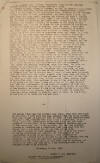
|
May 21, 1928.
Letter of Complaint, Pastora Blandón viuda
de Mairena, Jinotega, to Col. R. R. Wallace, Commanding
Chief of the American Forces in Jinotega.
[English translation
only.] "Mr. Colonel R. R. Wallace,
Commanding Chief of the American forces
residing in this Center section - City -
¶ I, Pastora Blandon, widow of
Mairena, of age, of domestic occupations,
and of this domicile, before you and with
all consideration, expose: that I am the
owner of an agriculture farm, situated at
the Pantasma Valley, (Guale) of this
jurisdiction, in which ranch I live, and
have lived for many years, working and
forming all that I possess for my small
children. ¶ In said ranch I had
cattle, hogs, chickens, and all that is
necessary for field work. Living as I do, in
the country, and without a doubt I am
exposed to all kinds of contingencies, but I
am not to blame for the situation of the
moment or what is going on in our country:
just the same, I have been a victim to the
abuse of the bandit troops commanded by
Sandino and after that I have been also a
victim of things done by the Marine Corps
who have come to guarantee order and peace.
¶ As I said before, it had been some
days before that Sandino's' troops had been
at my ranch and they forced me to give them
several head of cattle, sacks of coffee and
salt and other things that I had for me and
my family's personal use, leaving me a
receipt for the correspondent claim of every
thing taken: Subsequently, on the third of
April of 1928, a column of Marines arrived
at the same ranch, who were going in a North
direction, and after having searched my
house, and having found those receipts given
by the Sandinistas Chief, I was called a
Sandinista and then the destruction of all
my property started, furniture, animals and
all the fruit of the ranch. I had stored in
my house 25 sacks of coffee, in the raw,
that would give 10 sacks of coffee in gold;
twenty loads of corn a lot of lumber with
which I was going to build a house, as the
present one is in very bad shape and also I
had a man's saddle in full service with all
its equipment. ¶ The lumber was
totally destroyed, made fire wood, the corn
and coffee was scattered and ruined; my
clothes and those of my children were cut
into bits; two mules and a big mare, of good
quality were taken for the use of the
Marines, and I think that at present they
are at service here. Three fat cows were
butchered also two three year old bulls a
calf, four three year old cows, three or
four pigs and all the chickens in the coop.
In the same way were made into fire wood,
tables, desks, beds, chairs, boxes to dry
coffee with, pack saddles; to end it the
only thing left of my house was its name.
¶ Making the value of all lost in that
way, $660.00. Furthermore in the month of
December of last year when Colonel
Livingston went by my house, going north, in
pursuit of the bandits, he stayed 8 days at
my house, having had, all this time 180
mules in my pasture, saying that I would be
paid for pasturage which amounts to $150.00,
more or less, for the 8 days at the rate of
10 cents per day per mule. . . . [p. 2]
¶ The second time that the Marines
came here, when they destroyed my property,
I don't know how many animals they had in my
pasture only they stayed 15 days and that in
those 15 days they destroyed all what I own,
because they said I was a Sandinista, as if
a woman, alone and indefensive could have
party and political opinions. Furthermore,
to my foreman Gregorio Espinosa who was at
the ranch when the Marines arrived, and who
they tortured because of thinking him a
Sandinista they took away from him $40.00
that I had given him to buy some cattle
with. ¶ All that I expose for
your knowledge, I do it with the object of
having reparation and payment, and
furthermore to ask guarantees be given to me
because I have necessity of working and I
should not be exposed to any new offenses
they may cause me. I beg you, to take this
exposition before the Supreme Command if you
will, so that they give me security and
peace in my home, and tell me that if I may
wait reparation of the damages caused to my
property. ¶ Jinotega, 21 May,
1928 ¶ Pastora v. de Mairena"
|
|
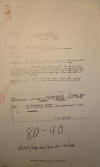
|
May 30, 1928.
Response to Complaint, Major B. S. Berry,
Matagalpa.
"1. The enclosed
letter was handed to the undersigned
recently by the writer thereof who lives in
Jinotega. (2) I questioned her
regarding the period of eight (8) days which
she says Captain Livingston spent at her
ranch and discovered she meant four (4)
actual days there being two periods of
twelve hours each in each day, which are
used in charging for pasturage. ¶
3. I am unable to state which patrol went
through Guale on April 3. It may have been
some of Major Rockey's column."
|
|
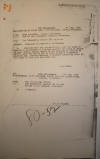
|
June 27, 1928.
"Complaint of Pastora V. de Mairena,"
Northern Area Commander J. A. Rossell,
Ocotal.
"9th Endorsement
¶ Returned with the recommendation
that the claim of Pastora v. de Mairena of
Jinotega against the Corps by reason of
Major Rockey having camped on her property
be settled at $87.37, plus the $40 now in
Major Rockey's possession provided she,
Pastora Mairenas, furnishes convincing proof
of her right to this last mentioned sum."
|
|
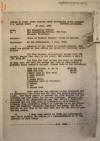
|
June 27, 1928.
"Claim of Pastora Blandon, widow of
Mairena," N. M. Shaw, Jinotega.
"1. Relative to the
claim of Pastora Blandon, this woman has
called at this office and given the
following information: ¶ (a)
That Captain Livingston's column with 180
animals stayed four days at her place, 180
animals 4 days @.20, $144.00. ¶
(b) That the last column was there on
Tuesday of Holy Week and that the damage was
done by this patrol (probably Major Rockey's
column). Claims loss of the following:
¶ 1000 lbs coffee @ .14 lb $140.00
¶ 4000 lbs corn $30.00 ¶
lumber used as fire wood $60.00 ¶
4 pack saddles ¶ 3 cows ¶
2 young bulls ¶ Furniture used
as firewood: ¶ 3 tables ¶
1 bed ¶ 3 canvas beds ¶
2. More articles are claimed in her
statement but in conversation the above was
all that was specifically mentioned.
She wants papers to protect her from Marines
but was informed the best place for her was
Jinotega. Liberals say the woman is
OK, Conservatives say that she is a
Sandinista. Espinoza has not been from my
information, with Sandino. Evidence
from creditable people in Jinotega is to the
effect that the Mandador (Gregorio Espinoza)
had money, $30.00 or $40.00, at the time of
the raid paid him for the sale of cattle and
coffee. ¶ 3. I have been unable
to obtain any information that would justify
the making of a recommendation as to the
justness of this claim."
|
|
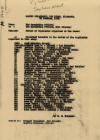
|
October 25, 1928.
"Roster of vigilantes organized at San
Lucas," E. H. Salzman, San Lucas (near
Somoto).
"1. Forwarded herewith
is the roster of the vigilantes organized in
this area: ¶
Jefe Juan Bautista
Rivera. ¶
Captain Joaquin Lovo
B. - Liberal - San Bernardo. [Joaquín Lovo
B.] ¶
Lieut. Abraham Vilchez
- Liberal - El Sipian. [Abraham Vílchez] ¶
Sgt. Gonzalo Hernandez
- Conservative - La Grama. [Gonzálo
Hernández] ¶
Sgt. Maximo Gutierrez
- Liberal – Sapotillo. [Máximo Gutiérrez] ¶
1. Gabino Banega -
Liberal - El Sipian. [Gabino Vanega] ¶
2. Jose E. Diaz -
Liberal - Inali. [José E. Díaz] ¶
3. Policiapo Espinosa
- Liberal - Mal Paso. [Policarpo Espinoza] ¶
4. Camilo Perez -
Conservative - Guilo. [Camilo Pérez] ¶
5. Augreliano Moreno -
Liberal - Cuyas. [Aureliano Moreno] ¶
6. Juan Carazo -
Liberal - Las Canales. ¶
7. Natividad Gutierrez
- Conservative - Los Canales. [Natividad
Gutiérrez] ¶
8. Santiago Moreno -
Conservative - Unile. ¶
9. Antonio Moreno -
Conservative - Unile. ¶
10. Abelisario Vasquez
- Conservative - Inali. [Abelisardo Vásquez]
¶
11. Tiofilo Banegas -
Conservative - Inali. ¶
12. Ysabel Gonzalez -
Conservative - Cuyas. [Ysabel González] ¶
13. Justiniano Miranda
- Conservative - Cuyas. ¶
14. Felipe Tescano -
Conservative - Cuyas. ¶
15. Anastacio Perez -
Liberal - Las Canales. [Anastacio Pérez] ¶
16. Sebastian Rivas -
Liberal - San Lucas. [Sebastián Rivas] ¶
17. Franimo Moreno -
Liberal - San Lucas. [Francisco Moreno] ¶
18. Mancz Omanzor
[Umanzor] - Liberal - Matasano. [Moisés
Umanzor] ¶
19. Octavio Mendez -
Liberal - Las Sabanas. [Octavio Méndez] ¶
20. Bugido Lopez -
Liberal - Quebrada Unile. [Bugido López] ¶
21. Jose A. Banega -
Liberal - El Sipian. [José A. Vanegas] ¶
22. Secundino Perez -
Liberal - Coyolito. [Secundino Pérez] ¶
23. Jeronimo Gutierrez
- Liberal - San Lucas. [Jerónimo Gutiérrez]
¶
24. Jose R. Albarado
[Alvarado] - Liberal - El Sipian. [José R.
Alvarado] ¶
25. Jesus Perez -
Liberal - Matasano. [Jesús Pérez] ¶
26. Carlos Dabila
[Davila] - Liberal - Santa Isabel. [Carlos
Dávila] ¶
27. Julian Sanchez -
Liberal - Santa Isabel. [Julián Sánchez] ¶
28. Juan Ramon Perez -
Liberal - Matasano. [Juan Ramón Pérez]"
|
|
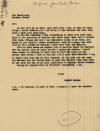
|
December 4, 1928.
Letter soliciting assistance, Carlos Haslam
from his finca in Jinotega, to General
Feland, Managua. "Sir:
¶ As you told me in April last that
when I was in need of something I could
address you I am doing it now because now
more than ever I need your good help.
¶ As you may remember I was
cooperating at that time with Capt. Hart in
the pursuing of the bandits and after Capt.
Hart left I worked with Capt. Phipps and now
I am completely alone in my farm, and hated
by the bandits. Pedro Altamirano, head of a
gang, has said that he will murder me
because I have been with the Marines.
¶ This is what makes me request you to
send at least ten Marines for two months
time at least whilst I gather my coffee. I
shall take charge of helping to take food to
them. The house in Las Brumas farm where I
live is big and I will give them whatever I
can in order that they may be well treated.
If you like you can send ten Marines and ten
rifles more in case the bandits come near
here we can find ten men of my full
confidence to capture those outlaws. ¶
Hoping my request will be favorably
considered, I am, ¶ Yours
¶ CARLOS HASLAm" [English translation
only]
|
|
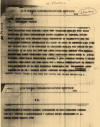
|
January 7, 1929 (1430,
1735).
Telegram from Enrique Gulke, Guale,
President of Junta Representing Coffee
Planters of Jinotega Department, to General
Feland & President Moncada, Managua.
"0507 FOLLOWING FROM
JINOTEGA QUOTE 0507 FOLLOWING MESSAGE FROM
GUALE PRESIDENT OF JUNTA REPRESENTING COFFEE
PLANTERS OF JINOTEGA DEPARTMENT WHICH HAS
BEEN FINANCING
PLATA EXPEDITION IS
TRANSMITTED FOR THE COMMANDING GENERALS
INFORMATION VIA RADIO IN ORDER TO EXPEDITE
SAME WITH THE REQUEST THAT IS TO FORWARDED
TO PRESIDENT MONCADA FOR ACTION BY THE
PRESIDENT IF HE SEES FIT 1430 MSG SENOR
PRESIDENT GENERAL JOSE MARIA MONCADA
EXCELXCISMO SENOR PRESIDENTE ESTA JUNTA
CAFETALERA DESEA SABER SI ACTUAL GOBIERNO
PUEDE PAGAR TRESCIENTOS SESENETA Y TRES
CORDOBAS SETENTA Y CUATRO CENTAVOS COMO
SALDO QUE DEBE HOSTA HOY A FUERZA
VOLUNTARIAQUE HA TENEDIT PARA PROTECCION DE
LA ZONA PRINCIPAL CAFETALERA DEL DEPARTMENTO
AROMO TAMBIEN SE DE EN ( GARBLED GROUP )
ADELANTE COLUMNA PUEDE CONTINUAL ( GARBLED
GROUP ) JIENDO L CHA ZONA POR CUENTA DEL
ESTADO PROTECCION Y INDISPENSABLE Y URGENTE
COLUMNA ACTUALMENTE EN ESTA ESPERANDO
ORDENES CON TODO RESPETO Y CONSIDERACION (
GARBLED GROUP ) PRESIDENTE DE LA JUNTAE
GULKE UNQUOTE 1735"
|
|
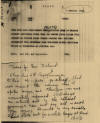
|
January 8, 1929 (0822, 1043).
Telegram from COBN
[Commanding Officer, Batallion] to COFI
[Gen. Feland, Managua?], with handwritten Memo
from H. Schmidt (B-3) to Gen. Feland.
"0508 YOUR
0508 0822 PERSON NAMED (PLATA) DECLINES TO
OPERATE WITHOUT ADDITIONAL FUNDS FROM THE
COFFEE JUNTA LATTER WILL ADVANCE NO FURTHER
FUNDS UNLESS ASSURED THAT NATIONAL
GOVERNMENT WILL REIMBURSE THEM THEREFORE
PATROL MENTIONED IS NOW AT STANDSTILL AT
JINOTEGA 1043" ¶ [Handwritten
note:] "Memo for Gen. Feland. I have had 5th
Regt. send message to have the Junta go
ahead. I had not received the message when I
spoke to you and therefore was not
accurately informed. I will also get an
estimate and if the national government can
not pay all, we could pay some. It would be
very desirable to have
Plata out for a
longer while at least. B-3 [Major Hans
Schmidt]"
|
|
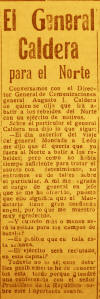
|
January 9, 1929.
"El General
Caldera para el Norte," La Tribuna
(Managua).
"Conversamos
con el Director General de Comunicaciones
general
Augusto J. Caldera de quien
se dijo que irá abatir a los rebeldes del
Norte con un ejército de nativos. ¶
Sobre el particular el general Caldera nos
dijo lo que sigue: ¶ — El día
anterior del viaje del general Moncada a
León me dijo que él queria que yo fuera al
Norte a batir a los rebeldes; pero como no
habia tiempo suficiente para tratar el
asunto con detenimieneto, no entramos en
detalles sobre el particular. A mi me agrada
el cargo de general en jefe se me ha
ofrecido, puesto que ello significa que el
Mandatario tiene gran confianza en mi, por
lo que me muestro muy agradecido. ¶ — Y
cuando más o menos será la salida para los
campos de batalla? ¶ — Es
posible que en toda esta semana. ¶
El ejército será reclutado, en esta capital?
¶ Todavia no lo sé; esos detalles
posiblemente he de conocerlos esta tarde
porque tendré una conferencia con el señor
Presidente de la República sobre este
importante asunto."
|
|
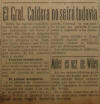
|
January 10, 1929.
"El Gral. Caldera no se irá todavía," El
Comercio, Managua, p. 1.
"Sobre las fuerzas
expedicionarias que irán a combatir a los
bandoleros del Norte al mando del
General
Augusto J. Caldera, podemos informar que se
dirigirán a las Segovias hasta después que
el General Caldera se someta a una delicada
operación quirúrgica dentro de dos semanas
más o menos. ¶ Fuerzas combinadas
¶ Las fuerzas del General Caldera serán
compuestas del soldados voluntarios y de
marinos del ejército de pacificación. ¶
El primer voluntario ¶ A su
oficina de Comunicaciones, entre varios
aspirantes a puestos del rama a su cargo, se
presentó antier un joven y le dijo al
General Caldera yo no vengo a buscar puesto,
General; lo que quiero es que me permita ir
con usted a combatir a los bandoleros. ¶ El
joven aludido se llama
Antonio Aguilar Jérez
y el General Caldera lo felicitó por su
determinación. ¶ Los solicitantes se
retiraron cohibidos."
|
|
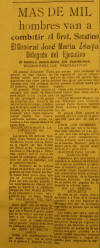
|
January 12, 1929.
"Más de Mil Hombres Van a Combatir al
Gral Sandino - El General José María Zelaya
Delegado del Ejecutivo - El General J.
Antonio Garcia, Jefe Expedicionario -
$45,000 Para Los Preparativos," La
Tribuna (Managua).
"El
General Alejandro
Plata estuvo en esta capital, habiendo
salido ayer para las posiciones que tiene
cerca de Jinotega con una columna de 50
hombres, más o menos. ¶ El General Plata
estuvo a recoger una suma de dinero para
pagar a sus tropas con la que persiguió a un
grupo de rebeldes que recorría las cercanías
de Jinotega, columna que dicen que jamás le
presentó acción, por lo que nunca pudo
combatir; pero logró capturar varios espias
con correspondencia, quienes sería remitidos
a esta capital dentro de pocos días. ¶
RECONCENTRARON A LA ESPOSA DEL
GENERAL ¶ La esposa del
general Sandino, doña Blanca Aráuz y los
hermanos suyos que se hallan en la región de
San Rafael del Norte serán reconcentrados
bien a Matagalpa o bien a esta capital, con
el objeto de evitar la constante
comunicación en que se hallaban con el
cabecilla rebelde. Un hermano de la señora
Aráuz de Sandino era el telegrafista de San
Rafael del Norte hasta hace pocos días; una
vez se intento sustitirlo, a fines del año
recién pasado y las autoridades se vieron
obligadas a volverlo a nombrar porque en San
Rafael del Norte no consentían a otro
telegrafista que no fuera Arauz. ¶
EL DELEGADO DEL EJECUTIVO
¶ Hace poco dijo un diario local que
el general José María Zelaya iría a Nueva
Segovia como jefe de las tropas que van a
combatir a los rebeldes de aquella región;
pero el nombramiento que el general Zelaya
lleva es el de Delegado del Ejecutivo.
¶ EL JEFE EXPEDICIONARIO
¶ Como jefe expedicionario de las
tropas que van al norte iría el general J.
Antonio García, que aunque poco conocedor de
las regiones en que se encuentran las tropas
del general Sandino, lleva gente que conoce
bien los terrenos en donde tendrá que
operar. Como jefes secundarios el
general García lleva entro otros a los
siguientes:
Coronel Bernabé Marenco,
Mayor Francisco Luis Gabuardi, Coronel Pedro
Barbas, mayores Pedro Antonio y Manuel
Aguilar, etc. ¶ El general Plata operará de
acuerdo con los jefes de la gente que está
para salir a esta capital. ¶
UNOS 1500 HOMBRES ¶
Los jefes que van a las Segovias están
alistado ya a su gente que será bien
escogida con el objeto de evitar
complicaciones. Varios artilleros serán
escogidos de la Guardia Nacional; pero la
mayor parte del ejército estará formado por
la gente civil. ¶ C$
45.000.00 PARA LA ORGANIZACIÓN
¶ El gobierno giró ayer contra el
superávit la suma de C$45.000.00 con lo que
se procederá preparar todo lo necesario para
el consumo de las tropas expedicionarias.
Los preparativos dieron principió bajo los
auspicios de la Guardia Nacional, habiendo
sido carga da en contra del pagador de la
Guardia la referida suma. ¶
EN LA SEMANA ENTRANTE
¶ El viaje de las tropas será a
mediados o a fines de la semana entrante; y
no sólo hombres de Managua sino que
Occidente ingresarán al ejército que se está
alistado. ¶ Las tropas que van a salir de esta
capital hasta Matagalpa viajarán en
automoviles y autocamiones; en Matagalpa
seguirán el camino a pie llevando el
aprovicionamiento en bestias de las cuales
hay un gran cantidad en aquella ciudad
esperando solamente la organización y
llegada del ejército para emprender la
marcha."
|
|
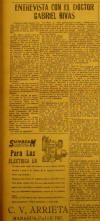
|
January 13, 1929.
"Entrevista con
el Doctor Gabriel Rivas," La Tribuna,
Managua. [A
polemical discourse on the "implacable y
despótico [y] autoritario" moral personality
of General Augusto J. Caldera]
|
|
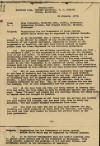
|
January 13, 1929.
"Regulations for the Government of those
Special Native Units which may be organized
by General Moncada," Northern Area Commander
Col. Robert Dunlap, Ocotal, to General
Feland, Managua. "1.
It is recommended that a letter of
instruction be furnished to the officer in
command of any native military unit,
exclusive of the Guardia Nacionale,
organized to assist in the suppression of
banditry, and that this letter include in
appropriate form the ideas expressed in the
following paragraphs. ¶ (a) The
purpose of the military operations, in which
you will be assigned a part, is the
suppression of banditry and the restoration
of law and order. To the end that these
operations may be most effectively directed,
the command of all military forces, U.S.
Marines, Guardia Nacionale and special
troops in the area concerend is invested in
the Area Commander, U.S. Marines. Therefore
you will report to the Area Commander, U.S.
Marines at Ocotal (Leon) and discuss with
him the mission of your unit. Therefore your
operations will be directed by this officer
or his duly authorized representative.
¶ (b) All of your operations must be
conducted with due regard to the laws of
humanity and the recognized rules of land
warfare. Women must not be harmed or
maltreated in any way. Innocent farmers or
civilians will not be harmed and their
property will not be seized. A just amount
will be paid for any service, food or other
property furnished by any one. You, or in
your absence the one who has command, will
be held responsible for the actions of your
unit. ¶ (c) At the same time you
will use every effort to destroy bandits and
those who have taken up arms in rebellion
against the government. Those "Civicos" and
others who are secretly aiding the enemy
must be hunted down and brought to justice.
¶ (d) You will remember at all times
that the marines and Guardia are your allies
and friends, and you must help them in every
way possible. You may expect similar
assistance from them. ¶ (e) You
must see that the men of your unit receive
the pay, clothing and other supplies to
which they are entitled, and equally, you
must see that they render in return the
service which is due your government.
¶ 2. It is further recommended tdhat
the bandit infested area be placed under
martial law by the President of Nicaragua.
This would greatly simplify the problems of
the military forces, and materially assist
in the elimination of banditry."
|
|
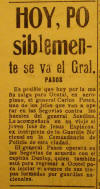
|
January 15, 1929.
"Hoy, Posiblemente se va el Gral. Pasos,"
La Tribuna, Managua.
"Es posible que hoy
por la mañana salga para Ocotal, en
aeroplano, el
general Carlos Pasos, uno de
los jefes que van a operar en las Segovias
contra las huestes del general Sandino.
Le acompañará en su viaje el joven
José de Jesus
Espinosa, ex intérprete de
la Guardia Nacional en la Comandancia de
Policia de esta ciudad. ¶ El
general Pasos operará en las Segovias de
acuerdo con el capitán Dunlap, quien también
está para regresar a Ocotal para iniciar el
avance de sus tropas por guardias
nacionales."
|
|
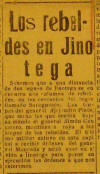
|
January 18, 1929.
"Los
Rebeldes en Jinotega," La Tribuna
(Managua).
"Sabemos que a
una distancia de dos leguas de Jinotega se
encuentra una columna de rebeldes, en las
cercanías de lugar llamado Saraguasca.
Las tropas del
general Alejandro Plata,
que serán las que tendrá bajo su mando el
general Simón
Cantarero, mantiene a raya a
las tropas de los rebeldes. El último
militar estufo en esta capital a recibir
órdenes del general Moncada y salió ayer en
avion a Jinotega para poner en ejecusión las
órdenes a que nos refirimos."
|
|
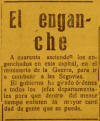
|
January 20, 1929.
"El enganche," La Tribuna
(Managua).
"A cuarenta
ascienden los enganchados en esta capital,
en el ministerio de la Guerra, para ir a
combatir a las Segovias. ¶ El
gobierno ha girado órdenes a todos los jefes
departamentales para que dentro del menor
tiempo enlisten la mayor cantidad de gente
que se pueda."
|
|
_small.jpg)
|
January 20, 1929.
"No
Estamos De Acuerdo Con La Expedición
Punitiva a Nueva Segovia," El Cronista
(León), reproducido en La Tribuna
(Managua).
"El asunto
del día es la expedición punitiva a Nueva
Segovia, para someter a Sandino para la cual
se están enganchando soldados en número
ilimitado con cuatro o seis generales que se
encargarán de dirigir las operaciones.
¶ Ante todo el pensamiento de la
victoria es el que priva en la expedición.
Nuestros soldados conocedores de lo que
significa una campaña en plena montaña, del
género de penalidades y de las grandes
privaciones que se sufren en esos sitios
abruptos, pantanosos a veces, cubiertos de
selvas impenetrables, van con gusto a esa
campaña; otros tienen ante sí la idea de la
victoria y allá van con entusiasmo como si
fueran a combatir en un tablero de ajedrez y
con gentes dispuestas a dejarse vencer.
¶ Por otra parte, veamos el reverso de
las cosas. Supongamos que el Gobierno sale
derrotado en la expedición. Cuales serían
las consecuencias de una derrota? Hasta
dónde puede llegar el desastre del Gobierno
del General Moncada? ¶ Digámoslo
de una vez, Esta expedición no debe hacerse
a tontas y a tantear locas. Hay que
considerar, que bastante es la posición de
Sandino, dentro de la República, dentro del
país; hay que conocer la extensión que tiene
el contagio de la rebeldía, el género de
propaganda que los mismos autonomistas han
hecho o están haciendo para conocer la
resistencia de los obstáculos con que se
tropezará. ¶ Por lo pronto lo
mismo Gobierno del General Moncada aún no
está consolidado. Hay grandes
inconformidades, porque resulta a estas
horas que todos se creen dueños de los
puestos públicos, que los empleados
conservadores, que aún se mantienen en sus
puestos son motivo de disgustos, para
quienes no han logrado asegurarse una renta
en los tesoros del Estado. ¶
Cual es el punto de vista de la actitud de
Sandino? Esto lo sabemos todos: Sandino
quiere que los yankees se larguen del país.
¶ El Presidente Coolidge, dijo en
noviembre pasado: ‘La tranquilidad en las
elecciones nicaragüenses y los indicios de
la satisfacción de ambos bandos al respecto,
han establecido las bases para el retiro de
las tropas hacia lo cual se ha adelantado
much en los pasados pocos meses. ¶
‘Se cree, añade el mensaje cablegráfico, que
Coolidge, desea probablemente que las
condiciones en Nicaragua se hayan restaurado
a su normalidad antes de dejar la
presidencia el 4 de marzo. ¶ ‘Las
fuerzas irán reduciendo gradualmente, hasta
dejar solamente la Legación o sea doscientos
aproximadamente’. ¶ Sobre la
base de esta promesa deben entablarse
gestiones amistosas con Sandino. Es mejor
llevarlo al convencimiento por la razón, que
no al sometimiento por la fuerza. Dentro del
terreno de la diplomacia hay mucho que
hacer, precisamente porque no se ha hecho
nada. ¶ Hace poco en una
interesante entrevista que hicimos al doctor
Escolástico Lara, nos dijo, que él podía ir
donde el General Sandino, siempre que se le
diera una promesa sobre lo que se desea.
Creemos que sto no está en las estrellas
para parometérselo y que esta promesa,
significa para Nicaragua el advenimiento de
una paz complete y el primer paso para la
reconstrucción de Nueva Segovia.
¶ — o — ¶ Hay otro punto que
considerar en el problema neosegoviano. El
del bandolerismo. Con el nombre de
sandinistas merodean por los caminos bandas
de individuous vagabundos, sin bandera
alguna, cuya única ocupación es el robo. Van
armados por los caminos pidiendo con el
rifle al hombro cuanto necesitan, ni más ni
menos que Gil Blas. ¶ Esto será
obra de pocos días; con éstos hay que obrar
rápidamente, para éstos, el exterminio es la
lay y para éstos precisamente deben armarse
los ochocientos hombres de que se ha venido
hablando. ¶ Debemos considerar a
estos bandos, como un producto de una guerra
larga y nada más. ¶ Hay un
factor que no debemos descartar en una
expedición punitiva: el adversario político,
que está durmiendo con cincuenta ojos,
mientras tiene abiertos los otros cincuenta,
listos para atravesarse al Presidente
Moncada y crearle dificultades en cualquer
momento y en cualquier circunstancia. El
conservatismo, unido a los sandinistas de
Nueva Segovia, puede ser el origen de la
conflagración interior. Talvez sea la chispa
del polvorín. ¶ Hay en este
problema puntos obscuros que no alcanzamos a
penetrar y aunque hay quienes aseguren que
todo esto es lirismo, es el caso que durante
tantos meses nada han podido hacer las
fuerzas estadounidenses. ¶ Lo
decimos claramente, no estamos de acuerdo
con esa expedición; queremos que se busquen
medios que esten de acuerdo con todos los
puntos de vista que presenta el problema
sandinista que no solo está en Nueva
Segovia."
Notes & Comments:
A penetrating and insightful analysis almost
three weeks into the Moncada administration.
Key nuggets: Here the Voluntarios are
called a "punitive expedition," versus the
official language as a "plan de
pacificación" (pacification plan). The
author — probably the 77 year-old founder &
editor of El Comercio, José María
Castrillo — asks what happens if the
expedition is defeated and suggests the
whole thing might backfire and spread "el
contagio de la rebeldía" it was meant to
suppress. He accepts that Sandino is
driven by patriotic motives, but that
"bandolerismo" in Las Segovias — criminals
acting in "el nombre de sandinistas" — is
also a big problem. The framing of
Moncada's government as not yet consolidated
is entirely accurate, as is the
recalcitrance of the Conservatives being
ousted, and the potential Conservative
menace if they ally with the Sandinistas.
Helps introduce some balance to the mostly
politically blind reports of the Marines.
|
|
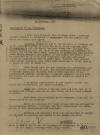
|
January 21, 1929.
"Memorandum To All Concerned," Major Hans
Schmidt, Managua.
"I have just returned
from Jinotega where I arranged certain
details in reference to volunteers for the
General and which you should know about.
¶
Clemente Torres / Torrez is
now in the vicinity of Jinotega and is to
organize a group of about 50. He is to be a
second jefe of Cantarere's [Simón
Cantarero] and eventually
may work under him. The plan for Torres is
that he will get 15 or 20 men together at
Jinotega, be given a few rifles and a small
quantity of ammunition, and proceed under
marine escort to San Rafael. At San Rafael
the patrol will be aughmented by 15 or 20
more volunteers and some additional rifles
and ammunition will be given them. They will
then proceed under marine escort to Yali
where additional men to bring them up to
about 50 men will be taken in. ¶
When Torres gets his men together for
operations (initially) in the vicinity of
Yali, the General desires that about 15
marines specially selected, with a very high
type of non commissioned officer, preferably
a gunnery sergeant, be put into the patrol.
At least six of these marines should be
armed with Thompsons. ¶ I am
making arrangements to get Guardia rifles
and ammunition to Jinotega, San Rafael and
Yali. ¶
Plata [Gen.
Alejandro Plata] will
recruit a few men here and will then go to
Jinotega and collect some men he left there.
He will then proceed to Ocotal. ¶
When dates are available as to movements,
they will be communicated to you promptly.
¶ Panel designations for these groups
will be arranged by the Commanding Officer,
Jinotega, who will communicate the
information to this Headquarters and
Aviation. ¶ Clothing and
equipment will also be provided by Guardia
and Marines in Jinotega and packed to San
Rafael and Yali. ¶ H. SCHMIDT by
direction"
Notes & Comments:
Here we learn the specifics of General
Feland's vision for the initial mobilization
of the Voluntarios in Jinotega under the
umbrella of authority of the Marines.
In retrospect it is remarkable that Feland
believed that this scheme would prove
workable. Feland became Commanding
General of the Second Brigade on 16 January
1928 after a 5-month hiatus (he relinquished
the position to Col. Louis Gulick in Aug.
1927). He kept the job for only 10
weeks (to March 26). Ironically, the
"gunnery sergeant" of a "very high type of
non commissioned officer" turned out to be
Gy. Sgt. William A. Lee, stories about whose
wanton violence & brutality toward civilians
circulated widely in the rural zones around
Jinotega & Yalí in subsequent decades.
|
|
_small.jpg)
|
January 22, 1929.
"También
voluntarios" / "Para el envío de
tropas," La Tribuna, Managua.
"Tenemos
conocimiento de que los hombres que han de
componer los resguardos de hacienda no serán
reclutados como se hacia antes. Los jefes
políticos de todos los departamentos han
recibido circular del Ministerio para que
procedan a buscar voluntarios. Se han dado
también las órdenes para hacer los uniformes
que serán azules, como antes de que fueran
su primidos los resguardos. ¶ Se
espera que dentro de unos quince días o más
tardar dentro de un mes, estarán funcionando
todos los resguardos nuevamente creados para
la persecución del contrabando."
Notes & Comments:
This piece spotlights another extant &
state-sanctioned violence-making group:
"Resguardo de Hacienda", under the authority
of the Ministerio de Hacienda — on the
lookout for illegal tax-evading activities.
A photograph of one Resguardo squad from
1928 is in
PHOTO-DOCS > USMC-GN, PAGE 1.
The Resguardo lasted into
1930 and in some ways after.
_____________________________________________________
"Para el envío de
tropas. En el
Ministerio de la Guerra estuvieron
trabajando los empleados durante todo el día
domingo girando circulares firmadas por el
Inspector General del Ejército
General Carlos
Pasos, relativas a la
expedición al Norte. ¶ En esas
circulares que fueron enviadas a personas
amigas del actual régimen, el general Pasos
pide que ingresen a las filas del ejército
que se está alistando o que busquen dentro
de su comprehensión respectiva, elementos
voluntarios y bien conocidos para que, en el
menor tiempo posible, esté formado el
ejército."
Notes & Comments:
Active urban recruitment via fliers sent to
select friends of Moncada. Carlos
Pasos seems mainly involved for his capacity
to recruit men.
|
|

|
January 23, 1929.
"Memo
For Colonel Dunlap," Major Hans Schmidt,
Managua, p. 1.
"One unimportant
change in reference to the movement of the
"Volunteers". Caldera [General
Augusto J. Caldera] will go
to Esteli on Friday and join the column
there. Pasos [General
Carlos Pasos] will go by the
same plane to Ocotal. The column should be
able to leave there by about 1000. ¶
Caldera, who is from Masaya told the General
this morning that he had some men coming in
here from there and wanted to take them with
him. The General [General Feland] was of
course unwilling to hold up the movement any
longer but asked me to tell you that if they
do come up there later, you could probably
juggle things so as to get them in. I doubt
if any are sent up. ¶ I am sorry
to have had to write you so many times about
the same things but you have no idea how
many changes have been made. The President
[Moncada] and his cohorts have made so many
changes, that the General has informed them
that it must stop. ¶
Navas
has been located and will probably be here
next week. ¶ If Dawson can get
away from here early enough tomorrow and the
Nicaraguans can stand the "gaff", they
should be in Ocotal Saturday evening or
Sunday morning. Although I originally set
the hour of departure as 8:30 because I had
been informed that Caldera could not leave
here until Saturday, I have just informed
Dawson that he may leave whenever he
desires. I believe his present plan is to
make Esteli the first night. ¶
Colonel Lowell, G.N. is the liaison officer
with the brigade for the voluntarios and he
has given instructions to other Guardia
Officers concerned to help in every possible
way. They are to make the necessary
arrangements for supplies, equipment and
money in every locality. The General desires
that there will be Navas and Caldera who are
to be paid as the Chiefs of the column in
the capacity of Scouts. Please tell Reagan
to take up Caldera on his payroll at $150.00
a month and including the 25th of January. .
. . "
|
|

|
January 23, 1929.
"Memo
For Colonel Dunlap," Major Hans Schmidt,
Managua, p. 2.
" . . . The affair at
San Antonio was a regretable thing for it
appears (although details are lacking) that
the patrol was two small for operations in
the bandit infested areas. ¶ Has
the detailed written report of the Davis
contact left your office? ¶ In
answer to your last two messagges; about
seventy five men will leave here and
therefore you will have room to inject some
into the group up there. Hat bands, arm
bands, etc. will be furnished and the
Guardia Officer there will be instructed to
do the same for up there or in case he does
not receive instructions, he will do it upon
your orders. ¶ H. Schmidt, B-3"
|
|
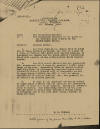
|
January 23, 1929.
"Special Patrol," Northern Area Commander
Col. R. H. Dunlap to "The Commanding
Officers of all posts in the Northern Area
visited by the DAWSON-PLATA patrol."
"You will furnish Lt.
Dawson with at least tw or three Marines on
demand, who will be a part of a force of
fifteen (15) armed with special weapons, to
accompany Lt. Dawson and the
Plata patrol
(volunteers) which will operate in the
north-western Nueva Segovia region. ¶
2. You will select Marine who are physically
fit, courageous and if possible possess a
little knowledge of spanish. Commanding
Officers should realize that this force of
Nicaraguans organized under tried leaders of
General Moncada will be invaluable as aid in
suppressing banditry and will be able to
obtain information of trails, bandits, etc.,
not possible to be obtained by Marines
unaided. ¶ 3. It will be the
quickest and surest method of suppressing
banditry and all officers are instructed to
give it their heartiest support. During Lt.
Dawson's march to Ocotal, each Commanding
Officer of the post through which he passes
will furnish a strong escort to accompany
him to the next post enroute capable of
doing the same." [Handwritten note at
bottom:] "Notice given of chg. from
Gen. Plata to Gen. Caldera"
|
|
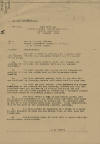
|
January 23, 1929.
"Instructions (Secret and Confidential)"
Col. R. H. Dunlap, Ocotal, to Second Lt.
Marion L. Dawson, USMC.
"1. You with a force
of fifteen (15) Marines armed with special
weapons will accompany
General Plata's
column at all times. ¶ 2. You
will treat General Plata with respect and
courtesy at all times but remember that you
are supreme commander. ¶ 3. You
will support this column in all actions and
endeavor to keep the column ever on the
aggressive after bandits. ¶ 4.
You will instruct General Plata to see that
his men (natives) in foraging provide
sufficient food for your men. ¶
5. You will see that General Plata conducts
his column according to the laws of war and
humanity, however you will not interfere
when you believe he is routing out those men
who accompany the different columns of
bandits for a specific purpose and then
return to apparently pacific pursuits.
¶ 6. You will retain a copy of
Air-Ground Liason Code No. 2 in your
possession at all times while operating with
these volunteers and communication by panels
will be conducted only by you or by the
Marines under your command. Panel
designations will be arranged by the
Commanding Officer, Jinotega. ¶
7. You will always be supported by a force
of Marines in your vicinity on whom you can
always rally or call upon for assistance.
¶ 8. The following route of march will
be used: JINOTEGA-ESTELI-PUEBLO
NUEVO-OCOTAL."
|
|
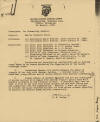
|
January 23, 1929.
"Native Volunteer Force, Memorandum for
Commanding General," Col. R. H. Dunlap,
Ocotal.
"1. Enclosures [6
total] are forwarded as confirmation and as
showing steps taken by me toward assisting
the organization of the native voluntary
force. ¶ 2. Lieutenant Dawson
will arrive Managua via plane on January 23
for duty with General Caldera. I consider
him a very excellent young officer and he
should perform this mission creditably.
¶ 3. Please advise if Gunnery Sergeant
Lee and his contingent of picked marines
will remain with
General Plata's patrol that
will operate initially in the vicinity of
Yali. I recommend that this be done in view
of the fact that these marines are now with
Torres and are acquainted with the
organization. Further, I shall be obliged to
furnish specially selected marines for both
native columns operating in Eastern and
Western Nueva Segovia respectively."
|
|
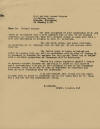
|
January 23, 1929.
"Memo for Colonel Dunlap" [in response to
Dunlap Memo of 23 Jan.], Major Hans Schmidt,
Managua.
"The last paragraph of
your memorandum of 23 Jan leads me to
believe that I have confused you in some of
the details concerning the volunteers. They
have changed things so much here that I have
had difficulty keeping up with the
situation. ¶ The old
Plata
group, now under
Cantarero is operating in
the Jinotega area and has
Lee and his
marines still with it. ¶ The
Torres group is being organized and after it
reaches Yali you will in accordance with my
memo of January 21 be expected to furnish
the marines for that group. About ten or
twelve with a suitable proportion of
Thompsons will be necessary. ¶
Torres has always expressed a desire to
operate against Centeno and initially at
least he will operate under instructions
from you in that vicinity if you do not
recommend otherwise. Later on he may be sent
to Cantarero or Cantarero may come up there
depending on the situation. ¶ I
do not believe that Dawson has had quite as
much time as would be desirable but he has
taken hold of the thing and I can not see
any difficulties ahead."
|
|

|
January 24, 1929.
"Notas: Se va General Flores,"
La Tribuna (Managua).
" . . . De un
momento a otro saldrá para Nueva Segovia el
general Felipe T. Flores, con el cargo de
Jefe Expedicionario de una parte de las
fuerzas que se organizan para combatir con
los rebeldes del norte."
|
|
_small.jpg)
|
January 24, 1929.
"La Región
Segoviana," editorial in Patria
(León), reprinted in
La Tribuna (Managua).
"Grandes aprestos
militares se están haciendo para iniciar una
campaña contra Sandino en la devastada
región segoviana. A la fracasada táctica
yanky que tiene más de un año de estar
operando sin ningún resultado, se le opondrá
la criolla, dirigida por jefes
nicaragüenses, pues se tiene el propósito de
hostigarlo y vencerlo con su mismo
procedimiento de emboscadas y de guerrillas.
Allá veremos, si no nicas, pueden más que
los yankees, contra sus hermanos que
enarbolan el pendón de la soberanía de
Nicardagua, y que por desgracia, el caos que
reina en la región segoviana ha dado origen
el feroz bandolerismo, que ha servido de
pretexto para considerar a Sandino como a
jefe de bandidos y ladrones. ¶ A
la verdad, que el gobierno de Moncada, con
esta expedición se va a jugar todo su
prestigio, pues se debe tomar en cuenta que
la América Latina, mantiene oido avizor en
todo cuanto se refiere al héroe de las
Segovias y si la tal expedición de generales
sale derrotada su fracaso repercutirá en
todo el mundo, agigantándose más y más la y
legendaria figura de Sandino, que como un
hércules moderno, quiere limpiar este
establo de Nicaragua, corrompido moralmente
hasta los tuétanos."
|
|
_small.jpg)
|
January 25, 1929.
"Notas: Se va
el Gral. Caldera,"
La Tribuna (Managua).
"El
general
Augusto J. Caldera, quien
fue designado al fin para que fuera al Norte
con las tropas como jefe expedicionario,
saldrá de esta capital hoy en aeroplano
hasta Estelí, de donde emprenderá el viaje
hacia Ocotal, por tierra, con la gente que
está preparada al efecto en aquella
población."
|
|
_small.jpg)
|
January 25, 1929.
"Suspensión de los
enganchamientos,"
La Tribuna (Managua).
"La
Comandancia General dirigió ayer circular a
los jefes Políticos de todo el país
ordenándole la suspensión de los enganches
de gente para ir a combatir al Norte hasta
nueva orden, dando a conocer que ya se
reunió el número de hombres que necesitaba."
|
|
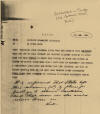
|
January 26, 1929
(1012).
Radiogram from District Commander Matagalpa
to CO Fifth Regiment, with handwritten note.
"0525 FOLLOWING FROM
JINOTEGA QUOTE 0524 LEE REPORTS THAT
CANTARERO DOES NOT TRY TO MAKE CONTACT AND
EMPLOYS DILATORY TACTICS TO AVOID SAME AND
THAT TORRES IS WORSE THAN EITHER OF THOSE
MEN FITTED AS A LEADER OF NATIVE VOLUNTEERS
WHAT I HAVE SEEN OF CANTARERO AND TORRES I
ABSOLUTELY AGREE WITH LEE TORRES HAS LEFT
JINOTEGA AND WILL BE ABSENT ABOUT A WEEK OR
TEN DAYS 1555 UNQUOTE MAJOR RECOMMENDS PEDRO
LOPEZ JEFE POLITICO OF JINOTEGA TO REPLACE
CANTARERO PERIOD 1012." ¶
[Handwritten note:] "R-1 informed that Plata
left this morning (26th) by plane for
Jinotega to relieve Cantarero, and that some
one else would relieve Torres. 1100.
Schmidt"
|
|
_small.jpg)
|
January 26, 1929.
"Los viajes en avión,"
La Tribuna (Managua).
"A las siete de la
mañana de ayer salió en hidroavión, con
destino a El Cabo de Gracias a Dios, el
Coronel José Saravia, nombrado Gobernador de
aquella comarca por acuerdo reciente del
Ejecutivo. ¶ A Estelí ¶
También salió a las siete y media de la
mañana de ayer, con destino a Estelí, el
general
Augusto J. Caldera,
acompañado del intérprete don
José de Jesús
Espinosa, con el objeto de
hacerse cargo de las tropas que como jefe
expedicionario llevará a Ocotal. ¶
El Gral. Pasos ¶ El
general Pasos
saldrá mañana con destino a Ocotal
acompañado de dos ayudantes suyos, como
Inspector General de las tropas
expedicionarias del Norte. Va en avión
también."
|
|

|
January 27, 1929.
"Memorandum for Major Schmidt," Col. R. H.
Dunlap, Ocotal.
"Referring to your
memo of the 25th, it is probable that
Navas
will prefer to select his own men for the
Murra Column. He told me that a large number
of his old men are now on the East Coast and
that he wanted them. Of course, to get the
best results the men must know their leader
and vice versa. ¶ I believe that
Navas can recruit a part of his force in
this Area, once he gets on the ground. This
will be an advantage, for, considering the
nature of the duty, hills people ought to
prove more suitable than those from the
large centers. ¶ [symbol '#' in
margins] Capt. Stockes reports
that recruiting for the volunteer force is
not popular about Somoto ------ only 12
recruits have been obtained thus far.
However, Lt. Dawson now has 82 volunteers
with his column, and that practically fills
the allowed strength for Caldera. Thus, you
see whe have no excess here. ¶ I
am inclined to think that the reported
disinclination to volunteer for service is
due mainly to the fact that the public does
not as yet know who the jefes will be.
[Handwritten notes at bottom:] #
Stockes says he can get recruits now -
probably 50 ¶ ## Note - sent
Caldera to Condega - he probably will arrive
today or tomorrow with his cal."
|
|
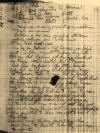
|
January 29, 1929.
Letter from Col. R. H. Dunlap, Ocotal, to
"Berk" (Col. R. C. Berkeley), p. 1.
"Dear Berk. ¶
Inclosed money in payment of my
indebtedness. Thanks [now] so much. ¶
Caldera & his army marched into town
yesterday afternoon from Pueblo Nuevo.
¶ They look pretty well. ¶
One of his Colonels --
Col. Cajani was
backed up at Caldera request - Dawson has
later told me that
Cajani
got drunk &
threatened his troops with a pistol - that
he Dawson had him confined - later letting
him go but as Cajani started drunken again
he Dawson told Cajani that he could no
longer exercise [the] command. I understand
the Minister of War [--] has ordered Cajani
back to Managua from Esteli - I have
instructed the C.O Esteli to honor the
order. The troops are short, some equipment
and the 30 additional sets ordered have not
arrived. If they do not come or are not sent
today will you make sure they are sent
tomorrow Wednesday 30. ¶ It is
important to show every effort to help at
this stage. ¶ I shall keep the
force here for 3 days - then send them to
Somoto where they will begin to operate.
¶ . . . "
|
|
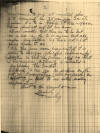
|
January 29, 1929.
Letter from Col. R. H. Dunlap, Ocotal, to
"Berk" (Col. R. C. Berkeley), p. 2.
" . . . 2 ¶
I am curious to find out immediately who is
to command the 25 men from Somoto. I believe
it is to be Felipe Flores - of Leon. Please
find out and let me know. ¶ I
have insisted that there are to be but 100
in all in the N.W. region and all under
Gen
Caldera. If this is not a fact please make
it so. ¶ If this force never has a contact
it is going to exercise a decided influence
for good in that the natives will see that
Nicaraguan authority is interested in
suppressing the bandits. ¶
Already I can see an evidence on the part of
the Conservatives (who fear much) an effort
to be first to us with every information.
¶ Best to the General & you, ¶
Sincerely ¶ Dunlap"
Notes & Comments:
Emphasis above is mine, for one of the most
revealing sentences in this entire
collection.
|
|
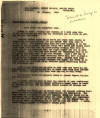
|
January 29, 1929.
"Memorandum for Colonel Dunlap: More
about the volunteer army," Major Schmidt,
Managua, p. 1.
"Navas is here.
Neither the General or I have seen him. We
are collecting his men for his selection and
no doubt we will get him out this week.
¶ General Feland asked me to write you
about some points in connection with his
column. Do you desire that they come to
Ocotal first? The General also asks for your
opinion as to the number of men he should
take and feels that about 120 should start
from there with the idea of subsequently
shaking them down to about 100 if you
consider that the right number for him to
have eventually. Also some men from Masaya
and Chinandega will be in the group who will
want to go with Caldera. Also a few may be
picked up and I believe most certainly
Navas
will have in mind a few good men he knows in
your eastern area. Please make such trades
of men between groups (Caldera and Navas)
(if Navas is to come there) as indicated in
my previous memos concerning Masaya and
Chinandega men. ¶ Even though
Navas may be able to find some men there do
you not consider it advisable for him to
leave here with from 100-200 men? No doubt
Caldera will lose some men and so will
Navas. ¶ If you have about 50
recruits there or around Somoto believe you
have plenty. ¶ It might help me
some to know the results of your conference
with Major Lowell. Has he placed sufficient
money there in hands of Guardia Officer for
all needs except payment of Caldera and
Navas? ¶ Caldera and Navas are
to select their own seconds sending their
names to President Moncada for confirmation
and commission. The only ones we are going
to pay are Caldera, Navas and Plata and as
indicated you in my message today not other
leaders are contemplated and no other groups
are to be formed. The man Flores has, as far
as we know, no standing and is not to form
any group. I understand
Juan B. Rivera is
Caldera's second jefe. ¶ . . . "
|
|

|
January 29, 1929.
"Memorandum for Colonel Dunlap: More
about the volunteer army," Major Schmidt,
Managua, p. 2.
" . . . If you
consider it advisable and I can help in any
way, I would be very glad to come up there
and talk things over with you or your
operations officer. ¶ H. SCHMIDT
by direction."
|
|
_small.jpg)
|
January 29, 1929.
"A Las Segovias,"
La Tribuna (Managua).
"Es posible que
mañana parta para las Segovias el ministro
de la Gobernación doctor Bernardo Sotomayor,
acompañado de un mecanógrafo o mecanográfa;
posiblemente vaya la señorita Matilde
Salcedo. El viaje será en aeroplano, y
durará unos tres días. ¶ El
señor ministro va a los departamentos del
Norte a conferenciar con los alcaldes y los
notables de 20 pueblos para ver de
solucionar el conflicto de aquellos
departamentos asolados por una guerra de más
de un año. En Ocotal esperará al señor
ministro el Alcalde de San Lucas para
acompañarlo a ciertas poblaciones de
jurisdicción."
|
|

|
January 30, 1929.
General Augusto Caldera, Ocotal, to Col.
Dunlap, Ocotal.
"Particípole que
Manuel Vásquez que salió de Tegucigalpa con
50 hombres fue batido por Sanabriga a 18
leguas de la frontera. Tengo informes que
Garvacio Baquedano [Verbonico
Vaquedano] va hacia San Francisco
Guajiniquilapa con 25 hombres y que de San
Marcos salieron 40 rifles para la frontera.
Felícito Moncada está listo para venirse á
Nicaragua. Un Gutiérrez sandinista que
estuvo a 3 leguas de Somoto hace 3 días dijo
que llegaría Sandino, que lo esperaran. Traje de esa 80 hombres, y el Coronel
Dunlop dice que aun no está autorizado para
completer cien. Yo necesito hacerlo con
somoteños conocedores que ya están listos me
dijo. Salgo rápidamente dentro de 3 días y
que si más tarde lo creía necesario
dividiera mis fuerzas en dos para mandarlas
donde fuera necesario. Dr. Sotomayor le
informará. ¶ Gral. Caldera."
[Original document]
|
|

|
January 30, 1929.
"Memo for Colonel Dunlap," Major Hans
Schmidt, Managua.
"The replacement for
Cajina should be called a Colonel, as no
additional Jefes or sub-Jefes are to be
employed as such nor is it desirable that
they be known as such. ¶ Do not
exceed total quota of 100 for
Caldera and
his Colonel. ¶ Is
Juan B. Rivera
acting as Caldera's second? ¶
When Caldera group is organized please let
us know how many excess are available there.
¶ Twenty additional replacements were
sent to Leon this morning to go up with
Cartwright. Others will go to Esteli by
truck when volunteers are moved either
latter part of this week or early next week.
¶ I have asked, through the usual
diplomatic channels, that Carmen Torres be
turned over to your command. ¶
H. SCHMIDT Major, USMC B-3"
|
|
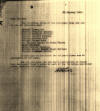
|
January 30, 1929.
"Memo for B-2," Major Hans Schmidt, Managua.
"The
following jefes of the volunteer army are
now at the aviation camp:
¶ General
Excamillo [Gen. Juan Escamilla]
¶
General
Gregorio Zeledon [Gregorio Zeledón]
¶
Colonel
Bernardo Vilchez [Bernardo Vílchez]
¶
Colonel
Leandro Parazos
¶
Colonel
Abraham Ruiz
¶
Colonel Moises
Ruiz [Moisés Ruiz]
¶
Lt. Colonel
Manuel de Jesus Correa
¶
Major Gerónimo
¶
Major Antonio
Membreno
¶
Captain Miguel
Manuel
Angel
Caldera
¶
Captain
Gerónimo Zavala [Gerónimo Zavala]
¶ In addition to
the above ten officers there are 42
volunteers at the camp. ¶ All the men had
one day's instruction on range: they have
each fired 5 shots in each of the following
positions: prone, kneeling, and standing. ¶ /s/ H. Schmidt"
|
|
_small.jpg)
|
January 30, 1929.
"Retiro de los
marinos," La Tribuna (Managua).
"Alabama,
28 Noviembre. Robert Narey de la
organización ‘Anti imperialista’ está dando
pasos para reunir a las familias de marinos
muertos en Nicaragua, con objeto de hacer
petición seria ante Hoover para que retire a
las fuerzas infantes estacionadas en aquel
país y dejarse libre al gobierno de Moncada
para que extermine la acción vandálica del
rebelde Sandino. Dice Mr. Narey: ‘Han
desaparecido de Nicaragua los gobiernos que
necesitan de nuestras bayonetas para poderse
mantener en el poder, nuestras fuerzas
garantizaron el libre sufragio de los
nicaragüenses resultando el Sr. Moncada, ser
el representativo legítimo de la voluntad de
aquel pueblo. Ahora dejémoslo solo que estoy
seguro cuenta con suficientes elementos
voluntarios para dominar a Sandino. No
tenemos necesidad de que nuestros inocentes
soldados sigan siendo diezmados en una
acción que ya no les corresponde’. ¶
Associated Press."
|
|
_small.jpg)
|
January 30, 1929.
"Nombramientos,"
La Tribuna (Managua).
"El
general Juan
Escamilla fue nombrado jefe
de la Columna expedicionaria que ha de
operar en el Setentrión de la república.
¶ El
coronel Juan B. Rivera fue
nombrado segundo jefe de las tropas
expedicionarias que operarán en el Norte
bajo el mando del
general Augusto J. Caldera."
|
|
_small.jpg)
|
January 31, 1929.
"Declaraciones
del Gral. Feland," La Tribuna (Managua).
"El
general Feland invitó ayer los Directores de
los diarios que se editan en esta capital
para hacerles algunas declaraciones.
Concurrieron el Director de La Prensa
don Adolfo Ortega Díaz, el de La Noticia
don Juan Ramón Avilés y de El Comercio
estuvo primero su fundador don José María
Castrillo y luego en su lugar su hijo del
mismo nombre. ¶ El general
Feland declaró que el
general Escamilla no
es el Jefe de las fuerzas expedicionarias
que operan en el norte, que el único jefe de
dichas fuerzas es él (Feland) y que la
cooperación del Gral. Escamilla, creyeron de
importancia por ser un experto guerrillero;
que por lo demás, no hay por qué temer nada
de él, puesto que no hará más que cumplir
las órdenes que le dé su superior; y además,
es de la completa confianza del Presidente
Moncada."
|
|
_small.jpg)
|
January 31, 1929.
"Escamilla en
aeroplano," La Tribuna (Managua).
"En
un aeroplano de los Estados Unidos partirá
para el Ocotal el
General mexicano Escamilla
para ponerse al frente de tropas que
operarán en el Norte.
|
|
_small.jpg)
|
February 1, 1929.
"Sigue el
enganche," La Tribuna (Managua).
"El
Gobierno envió a Masaya y lugares
circunvecinos una comisión que encabeza el
señor Héctor
Rodolfo Flores para reunir
más gente voluntaria que se aliste en las
filas del gobierno y vaya a combatir al
norte al mando de cualquiera de los
generales que operarán en aquella región.
¶ El inspector general del ejército,
General Carlos
Pasos dió poderes a
Flores para
desempeñar la comisión a que nos referimos
antes, habiendo partido ayer el comisionado
para volver cuanto antes a la capital.
|
|
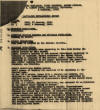
|
February 3, 1929.
Battalion Intelligence Report, 3rd
Battalion, 5th Regiment, Matagalpa.
". . .
General Plata
has a force of sixty volunteers here now [in
Jinotega City] and intends to take the field
when the Guardia District Commander has
received funds needed for his use, and
uniforms and equipment for men enlisted
here."
|
|
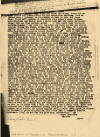
|
February 4, 1929.
Patrol Report, Lt. H. H. Hanneken,
Sacramento (near Murra).
"Following from
Hanneken at Sacramento. Quote.4 Feb. 1430.
Went out with Jiron and hiked all night/
Jiron did not guides here ) Returned to
Sacramento at 1400 to day. The place where
Jiron left Sandino is Chabarria (the owner's
name) between Mata-de-Guineo and Murra/ Have
a guide here now who knows Chabarria's
place/ Can you find another guide? I will
leave here to-morrow morning, Tuesday 5 Feb
with Lt. Walraven and about 30 men and
attack Sandino during the night, attempting
to enter the camp. If I can get another
guide will send detachment under Ridderhof
and McFarland to Mata-de-Guineo and operate
toward Chabarria/ Here is some dope:
Jiron states Sandino
has thirty men in his camp. Sanchez,
Estrada, Simon Gonzalez are with Sandino.
Sanchez has a light Browning. Sandino's men
have about 5 or 6 rounds ammunition, but
plenty of Springfield ammunition. Sandino
has never entered Honduras since his
banditry but has always had his camp between
Mata-de-Guineo and Chupon. General and
Colonel Montoya (Montolla) have quit Sandino
and have gone with a letter for the new
president of Honduras, Mejia Colindres, to
obtain permission for Sandino with 30 men to
pass through Honduras and then Sandino is
going to Mexico, for the purpose of
obtaining ammunition. Jiron has quit Sandino
and was on his way to Honduras when he was
captured. Jiron is a native of Guatemala.
Colonel Aponte Hernandez a Venezuelan, has
also quit and has gone to Venezuela. Jiron
thinks that Salgado is going to quit and
also all the rest except Ortez, who does not
get along with Sandino and who wants to be
the big jefe. (Ortez is a native of Ocotal
about 24 years old) Ortez has 60 men, 1
Lewis machine gun, 1 Light Browning, 1
Thompson and 60 good rifles with a good
supply of ammunition--, the best equipped
outfit. Ortez is now operating between
Ocotal and the Honduranian border. Pedro
Altamirano has always been an assassin, is
about 55 years old, has 30 men all
murderers, has one Lewis Machine gun and
operates between Jinotega-Santa Cruz and the
Cua/ and knows the country better than any
other bandit. Diaz from San Salvador about
40 years old, has 30 men, all rifles,
operating between Yali-Coco River. Salgado,
Nicaraguan, about 55 years old, has 30 men,
only rifles and is operating in the Somoto
area. Ferdinando Quintero, Honduranian has
quit and is in Honduras. The various
generals come to see Sandino about twice a
year for orders. Sanchez captured a German
boy at a coffee plantation at Balsamo about
Dec 2 who is still a prisoner. Sandino
wanted to execute him, but Jiron as Chief of
Staff objected to it and Sandino said he
should be killed, that he was a Saxon. Jiron
expects that now that he (Jiron) is gone
that Sandino will execute him. Mrs.
Williams, wife of Williams of Los Encinos
has been giving Sandino information since he
has been a bandit. Jiron thinks that
everyone of Sandino's men are disgusted.
Sandino has not even a penny. The men have
little ammunition and are only held by
threats of Sandino. Sandino has learned that
there are several columns of Nicaraguans
with Marines coming out and does not believe
it, but is seriously worried over it/
Sandino has not taken an active part in any
engagement so far. He is armed with a Colt
.44 special and a small bolo. Jiron when
captured had a Colt automatic pistol (non
govt) 35 rounds ammunition, Marine Corps
saddle. He speaks English well, appears
intelligent, is soldier of fortune 61 years
old, married, has a son (28) a daughter (20)
in Guatemala City/ He has and can give much
information. ¶ (Sgd) Hanneken ¶ unquote ¶
Confidential ¶ Geyer"
Notes & Comments:
This report was written the day after
Hanneken & Escamilla captured General Girón;
see
TOP
100 PAGE 27.
|
|
_small.jpg)
|
February 6, 1929.
"Rumor," La
Tribuna (Managua).
"Ayer
circuló la noticia, en esta capital, de que
el cabecilla Manuel María Jirón, uno de los
jefes sandinistas y de cuya captura hablamos
en nuestra edición de ayer, ya fue traido a
esta capital habiendo sido conducido
inmediatamente a la Penitenciaría.
Nada oficial se sabe.
Notes & Comments:
This little piece is noteworthy in several
ways. First, the headline seems pretty
emblematic of the Nicaraguan press during
this period, with "rumors" presented as
news. Second, the piece appeared only
three days after
Hanneken & Escamilla captured General Girón;
see
TOP
100 PAGE 27.
|
|
_small.jpg)
|
February 6, 1929.
"Los voluntarios
del general Escamilla," La Tribuna
(Managua).
"El
general
Escamilla acompañado del
general Carlos
Pasos estuvo en León a
buscar gente de enganche habiendo logrado
conquistar a 40 hombres, que llegaron a esta
capital el lunes por el tren ordinario. El
general Escamilla y el general Pasos debían
regresar a Managua, ayer, con otros cuantos
hombres. ¶ Ahora el viaje del
general mejicano a la zona Norte depende del
número de gente que consiga dentro de
algunos días más."
Notes & Comments:
Assuming the information reported here is
accurate, it is noteworthy that Gen.
Escamilla was in León recruiting men only
two days after he & Hanneken captured Gen.
Jirón Ruano (captured Feb. 3, Escamilla in
León Feb. 5).
|
|
_small.jpg)
|
February 7, 1929.
"Algo de lo que
dice," La Tribuna (Managua).
"El
señor Ministro de la Gobernación,
contestando a preguntas nuestras relativas a
su viaje a Ocotal, nos dijo: ¶ —
Puede decirse que los puntos de Somoto, San
Juan de Telpaneca, Dipilto, Ciudad Vieja y
otros tantos del departamento de Nueva
Segovia están completamente saneados de
rebeldes y todo el mundo puede transitar sin
los peligros de otros tiempos; pero
naturalmente las gentes de las montañas
siempre andan huyendo porque no existe en
ellas el espíritu de cohesión para
establecer la defensa de la comunidad;
ahora, de lo que se trata es de que esa
gente diseminada por todas las montañas se
repliegue en los poblados a fin de que cerca
de las gentes de la poblaciones se sienten
garantizadas y se den a labrar la tierra; el
Gobierno les proporcionará las facilidades y
cuando ya tengan algunas cuantas aves de
corral y cuenten con los ranchos de que
antes disponían en los mismos lugares que
ocupaban, construidos con el auxilio del
Gobierno, entonces serán restituidos a sus
pertenencias contando con los principios
para vivir, principios que no les sería
facil obtener de nuevo sin el decidido
auxilio del Gobierno. Se cuenta con que los
hombres que se retiren de los centros
poblados vuelvan a sus antiguas posesiones,
al cabo de cierto tiempo, con ideas nuevas
sobre la cohesión que debe existir entre los
asociados que vienen de fuera de la
comunidad. ¶ Esperamos, pues,
que dentro de unos veinte días, más o menos,
las poblaciones de Santa Maria y Macuelizo,
hoy completamente deshabitadas, hayan vuelto
a la vida ordinaria con el regreso a sus
hogares de las personas que ahora se
encuentran lejos, obligadas por las
circunstancias especiales que han imperado
desde hace tiempo en el departamento.
¶ Al referirse al desarrollo del plan de
pacificación, nos dijo, lleno de confianza,
que los líderes con quienes se entrevistó en
Ocotal están organizando en sus respectivas
jurisdicciones centros de propaganda
pacifista que deben estar trabajando con
ahinco en la consecución de los fines que el
Gobierno persigue.
|
|
_small.jpg)
|
February 7, 1929.
"Sobre el
Enganche," La Tribuna (Managua).
"El
Presidente de la República, acompañado del
Secretario de la Comandancia General,
Encargado de Despacho de la Guerra, estuvo
ayer por la mañana en el Campo de Aviación
en donde se alojan todos los voluntarios que
han de salir dentro de pocos días, bajo el
mando del
Gral. Juan Escamilla.
¶ El mandatario los arengó vívamente
encomiando su patriotismo y prometiéndoles
buenas recompensas para cuando vuelvan de
los campos de batallas del Norte. ¶
Los últimos hombres enganchados en esta
capital fueron: ¶ Miguel
Esguerra, Napoleón Sotelo, Miguel Miranda,
J. Sabino y Reinerio Rodríguez, Santos Roa y
Alfredo Acosta. ¶ Ayer volvió a
dar orden la Comandancia General de
suspender el enganche de liberales
voluntarios, pues considera que ya tiene el
gobierno número suficiente de tropas para
organizar una fuerte expedición.
|
|
_small.jpg)
|
February 10, 1929.
"En Yalí," La
Tribuna (Managua).
"Según
noticias recibidas por la Comandancia
General, el
General Alejandro Plata se
encuentra en la actualidad, con un puñado de
gente voluntaria, en las proximidades de
Yalí.
|
|
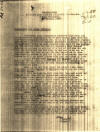
|
February 10,
1929.
"Memorandum for Major Schmidt," Col. Dunlap,
Ocotal.
"Reference your
memorandum received this date and re 50
selected Voluntarios to be sent here, I just
received a note from Captain Stockes who is
in the field with
General Caldera. He
reports that Caldera preserves excellent
discipline is aggressive etc. (In this
respect note that it was Pojingo [Simón
Jirón or Pichingo] and his
men who went out and got contact) That
General Caldera is anxious to get rid of a
lot of his men who are from the south, who
can not keep up and are in no way as
suitable for the work as are the men
recruited up here. Also that he wishes to
get rid of the discontents. That he wishes
to fill up their places with men recruited
up here. ¶ I got 25 men with
Pojingo for Caldera - I do not think he
wanted them at first. Now see his attitude.
I think it would be wiser to let me fill
vacancies as occurring by men recruited
here. ¶ Again I do not want
these 50 unless I can place them with either
Caldera or
Navas - or maybe you can
place them with
Plata. ¶
I have no room in this town for them and
would not like to send them off by
themselves unless there was a really
excellent native officer in command of them.
¶ In other words I don't think you
should get me to absorb any more of them -
certainly not at the present. Give me time
to shake these I have down and see them
doing good and then I maybe can use another
column. Really though they are not made good
unless they have a fair sprinkling of men
from this region and officers among them
too. ¶
Navas will probably not
get in until day after tomorrow - possibly
tomorrow ('') I will then see what he lacks,
try and get him outfitted by asking you to
send me stuff) and send him to the east.
¶ I am really pleased the way Caldera,
Stockes and Dawson have camped on the trails
of the bandits and the ground they have
covered. ¶ Please tell Colonel
Berkely that I will send Dawson in for
examination when I can get him. I want
Roberts to take his place. Is there not some
mistake about Dawson? He was examined about
one month ago and found physically unfit.
¶ Dunlap"
|
|
_small.jpg)
|
February 13, 1929.
"Recogiendo
armas," La Tribuna (Managua).
"El
Jefe Político de Matagalpa, general
Rigoberto Reyes, quien se encuentra gozando
de permiso en esta capital, nos informó que
en aquella jurisdicción se han estado
quitando armas a varios particulares; los
jueces de la mesta en combinación con los
marinos y los guardias nacionales están
efectuando esta obra con el objeto de
contribuir a la conservación del orden en la
región del Norte."
Notes & Comments:
This article is included mainly to
illustrate the disarmament campaign
unfolding at the same time that the
expeditions of Voluntarios were getting
underway.
|
|
_small.jpg)
|
February 13, 1929.
"Encuentro en
Nueva Segovia," La Tribuna (Managua).
"Noticias
telegráficas llegadas de Ocotal dan a
conocer que una patrulla de diez hombres
bajo el mando del
coronel Simón Jirón C. [“Pichingo”],
tuvo contacto con un grupo de rebeldes cerca
de la presa de ‘El Zapote’ el 8 del
corriente a 10 millas al suroeste de Santa
Maria. ¶ Los informes agregan
que no se conoce el número de bajas que se
le causó a los rebeldes; pero se sabe que
les fueron arrevatadas 8 mulas, 3 caballos,
3 monturas y 2 alforjas. ¶
El General Caldera
¶ Se sabe también que el
General
Augusto J. Caldera, que
opera en la zona del norte con un grupo de
voluntarios, se halla a 5 millas de suroeste
de Las Manos, cerca de la frontera con
Honduras."
|
|
_small.jpg)
|
February 15, 1929.
"De nuevo al
Setentrión," La Tribuna (Managua).
"Ayer
regresó en avión a Nueva Segovia el
general
Augusto J. Caldera después
de haber conferenciado con el Presidente de
la República sobre las nuevas excursiones
que ha de realizar para ultimar la empresa
que le fue encomendada."
|
|
_small.jpg)
|
February 21, 1929.
"Serio Encuentro
de Guardias con Rebeldes," La Tribuna
(Managua).
"Jinotega,
20 de Febrero de 1929. ¶ Señor
Comandante General. ¶ Tengo el
honor de comunicarle a Ud. que ayer, entre
las once y las doce de la mañana, en el
lugar ‘La Pavona’ de esta jurisdicción, hubo
un encuentro entre un destacamento de
Guardias Nacionales y una cuadrilla de
bandoleros; el resultado fue que los
bandoleros huyeron dejando como veinte
muertos en el campo y de los Guardias hubo
tres heridos; uno de ellos de bastante
gravedad. ¶ La cuadrilla andaba
al mando de Pedro Altamirano (a) Pedrón.
¶ Del
General Plata se sabe por
comunicación que recibí ayer, que se
encuentra en Yalí a donde se retiró para dar
descanso a sus soldados después de varios
días de recorrer las montañas de Yalí, sin
niguna novedad. ¶ Jefe Político
¶ PEDRO J. LOPEZ"
|
|
_small.jpg)
|
February 23, 1929.
"Montañeses de
Yalí," La Tribuna (Managua).
"EN
JINOTEGA. ¶ En la Comandancia
General se ha recibido la noticia de que un
grupo de 200 montañeses de Yalí, se presentó
a las autoridades de Jinotega con el
propósito de hacer una manifestación pro
Gobierno Constituido. Las autoridades de
aquella cabecera han ofrecido en la
población garantías a los montañeses y han
dado los pasos necesarios para proveer a su
alimentación. Se piensa en asegurar
trabajo a esos hombres en la recolección del
café en la zona jinotegana. Lo mismo
que en Ocotal se formará una Junta en
Jinotega para que trabaje en beneficio de la
paz y una pronta reconstrucción en las zonas
afectadas."
|
|
_small.jpg)
|
February 23, 1929.
"De Matagalpa"
La Tribuna (Managua).
"12
de Febrero de 1929. Señor Director de ‘La
Tribuna’. ¶ Managua. ¶
Existe en este Departamento un grupo
considerable de autonomistas que con fe y
entusiasmo apluden su patriótica actitud y
están dispuestos a colaborar con el
conglomerado de esa para todo lo que tienda
a la liberación y progreso de nuestra patria
por los medios que aconseje la Directiva de
esa capital. ¶ Efectos de la
pacificación americana ¶
Persona que nos merece todo crédito, llegada
de Jinotega nos informó lo siguiente:
¶ Que en el paraje ‘La Pita’ en la
montaña de la jurisdicción de dicha ciudad,
un grupo de marinos llegó a casa de Cruz
García, y registrando la casa dicen que le
encontraron unos tiritos de la U. y unos
pocos de Sprinfields. Esto fue motivo para
que a García que se encontraba trabajando,
en paños menores, lo capturaran y lo
culatearan hasta hacerle brotar sangre de la
cara y de la cabeza, y lo condujeron a casa
de Salvador Picado, como a tres mil varas de
distancia de la de García y lo fusilaron sin
llenar ninguna fórmula, como matar un perro
rabioso. La casa de Salvador Picado queda
dentro de la montaña a medio día de camino
del camino real que de Jinotega conduce a
Bocaisito. ¶ El grupo de marinos
autor de este asesinato forma parte del
destacamento que permanece en Poteka
[Poteca] embarcadero del río Wanky [Río
Coco]. De esta clase de asesinatos han
ocurrido en todos los caseríos y montañas
tanto de esta jurisdicción como de la de
Jinotega, y esto ha contribuido para que se
haya hecho más encarnizada y dilatada la
lucha libertaria de Sandino . ¶ La
Guardia Nacional en este Departamento deja
mucho que desear, sobre todo la que
permanece en los pueblos de la jurisdicción,
en donde ejercen toda clase de violencias
con los habitantes de los pueblos, caseríos
y haciendas. Si este cuerpo no se selecciona
y se instruye en sus deberes cívicos no se
sabe a que extremos vamos a llegar. ¶
Muy adelantados van los trabajos del puente
de hierro y base de cantera que se construye
en el río de ésta por donde pasará la
carretera para esa ciudad. ¶ La
Jefatura de Sanidad está procediendo con
actividad a la vacunacián para evitar en lo
posible el flajelo de la viruela y sus
derivados. ¶ CORRESPONSAL."
|
|
_small.jpg)
|
February 24, 1929.
"Notas —
Refugiados en Jinotega," La Tribuna
(Managua).
".
. . Los refugiados en Jinotega de las
montañas de Yalí son 240, en su mayoría
cafetaleros. . . ."
|
|

|
February 25,
1929.
"Memo. for Gy. Sgt. Lee," Major Schmidt,
Managua.
"Your report of 22
February is not quite as complete as I would
like to have it. You do not state who killed
the man. Did Plata do it himself or order
it? Did marines have anything to do with it?
Why didn't you advise him not to do it?
¶ Military commissions have been
formed to try cases under Martial Law and no
one in the field is allowed to kill an
outlaw. That is for the military commission
to decide. ¶ Regardless of what
you believe to be right you surely can see
that such actions will make things very
difficult for us. There is a military
commission in Jinotega and one in Ocotal.
¶ I understand that the President sent
orders to Plata not to kill people in the
manner he did. ¶ The burning of
known bandit houses is legitimate, but do
not burn any others for all the people who
have been driven out of that area must have
some place eto live later on. ¶
Until further orders do not go North of the
Coco without permission from Brigade
Headquarters. ¶ I believe you
are doing some good work but be careful and
do not go too far."
[NOTE:
Lee's report of 22 February has not been
found]
|
|
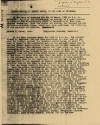
|
March 8, 1929.
"Court-Martial of Andrez López, in the Camp
of Oconguas," General Juan Escamilla, et
al., p. 1.
"In the camp of
Oconguas the 8th of March, 1929 at 8 a.m.
convened. Convened the undersigned, as
members of a court martial by order of the
expeditionary chief of Volunteers of this
zone, General Escamilla, with the object of
knowing the charges against the prisoner
Andrez Lopez, which have been preferred; the
following is the case and its results.
¶ Manuel J. Corea, Pres. Deogracias
Moncada, Secretary ¶ At the Camp
Oconguas March 8th 1929 at 8 a.m. The
present Fiscal W. Espinosa, who has been
questioned in order that he may make the
charges against the prisoner Andrez Lopez,
he said: “1. That he knows by the confession
made by the prisoner Lopez that he has had
active participation in banditry and rebelry
commanded by General Sandino, the declarer
states that upon going out upon a commission
with the said prisoner as a guide, he said
that he knew where to find water because he
had once seen the wife of the bandit
Salgado, come out from there after taking a
bath, he sent to see if it was true, it
being true that there was water in the place
indicated by the prisoner Lopez. 2. That in
the moment of being captured in his camp,
that is the right name for it although it
was deserted and captured by the vanguard of
General Escamillas army, it is possible that
he had been in this camp for several days
and according to what was found there it was
clear that he was not there by himself. 3.
That the person interrogated about the
different places confessed that it was true
that he had remained in said camp several
days fleeing from the aeroplanes and that he
was alone; but according to the inspection
of said place we judge that not alone was he
in company of other persons but was also a
spy of the bandits, communicating as the
first opportunity the advance of the forces
of the Volunteers. 4. That also he said to
the sentries that guarded him, that it was
true that he knew several of the chiefs
under Sandino, he also gave the names; he
also manifested that a daughter of the
prisoner Lopez, was the mistress of one of
the aides of Sandino, by name Monico
Peralta. 5. That having been interrogated by
the General about what he had said to the
sentries he answered, that he promised the
General that he would show him where he
could find some of the bandits and the
secretary of Sandino, who is called
Cupertino Rivera, upon a commission to the
places indicated by him he confessed that he
did not know the places of which he had
spoken before, that is, he tried to make a
fool out of the General and the commission.
According to what is here written a true
confession of the prisoner, I beg that this
Honorable Tribunal declare that he is guilty
and in name of the Public, the welfare, and
justice for the Nicaraguans capital
punishment be applied as an example to the
bandits. This was said and signed with the
Secretary M. J. Corea, President, W.
Espinosa, Fiscal, Deogracias Moncada,
Secretary, Luis Rivera Antrada, Counsel for
the defense. . . . "
|
|
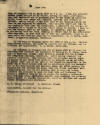
|
March 8, 1929.
"Court-Martial of Andrez López, in the Camp
of Oconguas," General Juan Escamilla, et
al., p. 2. "Camp
of Oconguas 8th of March 1929 at 9 a.m. I
had the prisoner Andrez Lopez brought to my
office, asking his name, profession, age,
and residence and he answered that he was
named as mentioned above, forty nine years
old, married, laborer, and resided in
Quilali, asking him if it was true that he
was working during the time he was captured
he answered, that he lived there and that he
was trying to hide from the aeroplanes, I
preferred the charges of belonging to a
column of bandits, which charge he denied, I
read to him the charges made by the Fiscal,
he answered, that all quoted as his having
said was true, denying as before that he was
affiliated with banditry, he said this and
he read his statement, found it in good
order and does not sign due to ignorance.
M.J. Corea, President, Deogracias Moncada,
Secretary. ¶ In the Camp of
Oconguas March 8th 1929 at ten a.m. Colonel
Luis Revera Andrada, was named as counsel
for the defense, and he accepted the
appointment. J. M. Corea, President. ¶ In
the Camp of Oconguas the 8th of March 1929
at 11 a.m. the court-martial convened and
consisted of Colonel M. J. Corea, Pres. Col.
W. Espinosa, Fiscal, Luis Revera A counsel
for the defense and Deogracias Moncada,
Secretary. After having examined the present
statements, they decree; that the prisoner
Andrez Lopez is guilty of the crime with
which he is charged, as an agitator of
public order and of the laws of the
Republic: according to the merit which these
crimes lend and in accordance with the
martial law of the Constitution and Military
Laws, and after hearing the Counsel for the
Defense who said, that his client confessed
said declaration and that he had nothing
more to say; and having notified the
prisoner to make his last will and testament
the prisoner answered that he had no reason
for making a testament. This Tribunal being
in complete accord, they sentence the
prisoner Andrez Lopez, to capital
punishment, which we ratified and signed
before the authorized secretary. ¶
M. J. Corea, President W. Espinosa, Fiscal
¶ Luis Rivera, Counsel for the Defense
¶ Delgracias Moncada, Secretary."
|
|
_small.jpg)
|
March 10, 1929.
"De Somoto," La Tribuna
(Managua).
"El
general
Augusto J. Caldera salió
ayer de Somoto para Ocotal de donde volará
con destino a esta ciudad, de hoy a mañana.
¶ Y vice versa ¶
En cambio
general Felipe T. Flores
salió de Ocotal para Somoto a hacerse cargo
de las tropas que comandaba el general
Caldera."
|
|
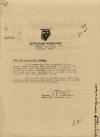
|
March 12, 1929.
"Memo for Commanding General," Col. R. H.
Dunlap, Ocotal. "MEMO
FOR COMMANDING GENERAL: ¶ It is
understood that President Moncada
contemplates offering
Lola Matamoras to
Managua, and holding her under surveillance
there. I have no objection to this
procedure, and am inclined to think it a
good riddance. Attached is a pamphlet which
just arrived in the mail addressed to her.
¶ Gen. Caldera
has apparently become
much interested in this woman and he may
have something to do with the plans for
ordering her to Managua. ¶ R. H.
DUNLAP, Colonel, U.S. Marine Corps,
Commanding Northern Area."
|
|
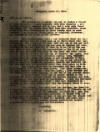
|
March 12, 1929.
Report by Voluntario General Juan Escamilla,
Oconguas, to Col. R. H. Dunlap, Ocotal
(English translation only). "The
present is to salute you and to render a
report of this district. I have explored
well this district, all through Oconguas,
Remango and La Luz, and I have only found
old camps, all the people have fled from
this district. These camps have been
dis-occupied at least twenty days or more.
Tomorrow I am going to leave, going to
Congojas, Chicheana, and Paredes to the
North of Mt. Paredes. ¶ Mr.
Andres Lopez, whom I had captured about six
days ago had told me that he would take me
to where there were some Sandinistas, but I
was out two days with him and he did not
lead me any place. He knew everyone and gave
me excuses for them, although he did not
give any of them up to me, he is the one
that told me that Sandino had concentrated
on the 12 of February 35 men, and told them
that he who loved him would follow him and
that he did not see any way of escape. Mr.
Lopez says that he does not know what
directions Sandino took, but that Sandino
knew that they were going to put Volunteers
in this deployment with the Marines and that
it was probable that he would be found and
captured, that 35 men followed him and the
rest went to Zapotilla where they were going
to hide. ¶ Mr. Lopez says that
he knows that all that live in this district
left for the same place. The Pedro
Altamirano has gone towards Jinotega. With
Mr. Lopez, I also carried out the order I
have about bandits, on the 9th of the
present month. ¶ I believe that
there may be people hidden in the district
of Murra, or that around the Encinos [Los
Encinos] los Guilians [la famila Guillén] has them in hiding, or they have
gone to Zapotillal. I work day and night so
pray within a month and a half I will have
fulfilled my promise to you, that within
that time the country would be tranquil.
¶ You Colonel, know well that Mr.
Guiliara [Guillén], has been for a long time helping
the people of Protrerios [Los Potreros], El Silencio and
all in that vicinity, also of the Encinos
[Los Encinos].
It would be a good idea that when we move
our camp from Oconguas, we should camp for 3
or 5 days in Protrarios [Los Potreros], so that we may get
all the people that are in those mountains,
of whom the majority are armed men. ¶
Awaiting your orders, please receive the
warmest salutations from myself and the
Volunteers. ¶ Sincerely, ¶
S / Escamilla."
|
|
_small.jpg)
|
March 10, 1929.
"Notas — La
Quieren en El Sauce ," La Tribuna
(Managua).
"LA QUIEREN EN EL
SAUCE ¶ Los vecinos de El Sauce
se han dirigido a las autoridades del
gobierno pidiendo que se mande a aquella
población un piquete de guardias nacionales
con el fi de que los garanticen contra la
criminalidad."
|
|
_small.jpg)
|
March 14, 1929.
"Las Cosechas Se Han
Perdido," La Tribuna
(Managua).
"En esta capital se
encuentran el señor Gilberto Morales,
director de policía de Jinotega, quien nos
suministró los datos que siguen, relativos a
la situación difícil que atraviesa el
departamento de donde es autoridad. ¶
El General Plata en Yalí ¶
El General
Alejandro Plata se encuentra
en Yalí con 100 hombres bien armados y con
un grupo de nueve ametralladoras que le
sirven para la defensa de la zona cafetalera
mencionada. Ha logrado mantener la
tranquilidad en una gran extensión en donde
tiene escalonados a sus hombres; pero en
resumen el resultado conseguido no es tan
práctico porque la mayor parte de las
cosechas de Yalí, zona eminentemente
cafetalera, no puede ser sacada al exterior
de las montañas porque los propietarios
tienen miedo de exponer sus productos y la
gente que los transporte a los actos de
violencia de los rebeldes. ¶
Más de 15 mil quintales de pérdida ¶
Se estima que más de 15 mil quintales de
café perderán los propietarios de Jinotega.
Pedrón estuvo en la vecindades de la
cabecera de aquel departameneto por espacio
de unos ocho días, pero eso fue suficiente
para meter miedo a la gente honrada que dejó
de trabajar; además, está siempre palpitante
la amenaza de otroas pequeñas columnas que
se dice permanecen en las vecindades de
Jinotega esperado un momento oportuno para
invadir de nuevo las zonas agrícolas.
¶ En el mismo Yalí no se pudo cosechar
todo el café; muchos de los pequeños
productores no recogieron ni un grano.
¶ Pedrón se llevó un gran botín
¶ Pedrón Altamirano se llevó un gran
botín después de su excursión por las
vecindades de Jinotega. Se calcula que se
alzó con más de C$ 5 000 en mercanderías,
alhajas y efectivo. ¶ Pedrón
estuvo con su banda compuesta como de
sesenta hombres a legua y media de la
cabecera sembrando gran alarma en los
ciudadanos pacíficos. ¶ El la
actualidad Pedrón ha ido a refugiarse a las
montañas de La Virgen y Guapinol, lugares en
donde tiene su centro de operaciones.
¶ Allí está Sandino? ¶
Los habitantes de Jinotega que están viendo
más de cerca los asuntos que se desarrollan
por aquellas regiones, suponen que Sandino
no ha abandonado su campañ y que las
noticias de que se encamina a México o a la
Argenetina carecen de fundamentos, según
todas las probabilidades. ¶
Salgado cerca de Somoto ¶
Por otra parte hemos tenido noticia
suministrada por persona que acaba de llegar
de Nueva Segovia, de que Carlos Salgado se
encuentra con una pequeña columna de hombres
a 3 leguas de Somoto. Se habla también de la
existencia de otras pequeñas columnas que
recorren la zona de Somoto, lo mismo que la
de Jinotega. ¶ Los vecinos de
esta útima ciudad se hallan exasperados y se
han dirigido al gobierno pidiéndole que
ponga aaaalos medios conducentes a prestar
garantías a los habitantes de toda la
región, pues la vida se está haciendo
imposible con la constante zozobra
introducida por la existencia de esas
columnas de rebeldes. ¶
Volvieron a sus propiedades ¶
Los 250 hombres que de Yalí llegaron a
Jinotega en vez pasada, volvieron a sus
propiedades llevando la promesa del gobierno
de que les garantizarla en sus vidas y
haberes. Se les ofreció también que se
proveería a sus necesidades de conformidad
con las facultades del gobierno. ¶
De esa promesa se derivó la creación
inmediata de la junta de pacificación que
empezará a funcionar en breve en aquella
ciudad.
|
|
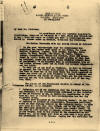
|
March 15, 1929.
General Logan Feland, Managua, to US
Minister Charles Eberhardt, Managua,
including report of Voluntario General
Augusto Caldera, p. 1. "My
dear Mr. Minister: ¶ In
accordance with the American Legation’s,
Tegnoigalpa, despatch of February 26 – 3 pm,
which you transmitted to me, I have the
honor to inform you that on investigation
conducted by forces under my command,
discloses the following: ¶ The
Marine Commander with the patrol states as
follows: ¶ “In the past
thirty-eight days the undersigned has
patrolled the border from Oyote to San
Pablo, via Santa Emilia, Calpulos, Zapotal,
Bado Grande, Suyatal, Santa Maria, El Yano,
Brajil, Los Minos, El Posto, Volean, Jalapa,
Toteoasinte, Guineo and Paredes, about 250
miles. There is little doubt that the bandit
groups, if they feel so inclined, cross the
frontier into Honduras without fear of
punishment. It is believed this is
particularly true of the border between
Oyote and El Posto and between Tetacasinte
and San Pablo. ¶ We were not at
any time in Honduras. In fact we followed in
general the Rio Poteca from Guineo to
Parades, keeping to the West of same and in
one case where the trail appeared to cross
the river and go into Honduras we turned
southwest and passed between the summit of
Monte Negro and the Rio Poteca, cutting our
way with machetes for the best part of the
day, Feb. 22nd.” ¶ The report of
the Nicaraguan General in charge of the
Volunteer Forces, is as follows: ¶
“Informing you of our excursion over the
Northern Frontier, and referring to the
communication addressed to the Minister of
War of Honduras by Mr. J. Gamero M.,
manifesting to you that all that is stated
in that communication has not the slightest
truth. ¶ Events have happened in
the following manner: On the 20th of
February we arrived at Totcoacinto
[Teotecacinte], Nicaraguan territory, where
we were royally treated by the Bellorin
family, to whom were paid two cows that were
killed, and in the valley, all the tortillas
consumed by our forces were brought there.
On the 21st we left enroute to Guineo,
without being one moment in Las Trojas, such
as was stated in the communication referred
to. In no other part have we paid such a
high price for provisions as at El Guineo.
Paying for the tortillas two . . . "
|
|
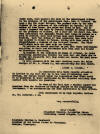
|
March 15, 1929.
General Logan Feland, Managua, to US
Minister Charles Eberhardt, Managua,
including report of Voluntario General
Augusto Caldera, p. 2.
" . . . cents each,
said payment was made by the undersigned
Caldera in the presence of the undersigned
Capt. Geo. F. Stockes, the same a pig for
eight dollars, the payment made by the same
Caldera in the presence of the referred to
Captain, to the mother of Jose Arauz, the
price was fixed by her. And to Arauz a
payment was made by Captain Stockes of seven
dollars in the presence of Caldera, for a
calf not two years old. This same individual
and Apolonio Valica were taken as guides on
a road to Parades, said road having been
used formerly by the bandits. Upon the
ending of this excursion they were paid and
allowed to return to Guineo, taking with
them owing to forgetfulness a machete of the
National Forces. The other individuals have
not been with our forces. ¶ We
believe we should manifest to you that these
individuals according to their own
statements have been born and raised on
Nicaraguan territory. ¶ In
regards to the violation of women or
attempt, we judge absolutely impossible,
because the ones that are there are so
filthy and repulsive that they would not
incite the most careless soldier. ¶
We have answered with the most absolute
truth the false charges of Mr. J. Gamero M.,
who undoubtedly has been duped. ¶
AGUSTO J. CALDERA.” ¶ In connection with these
reports attention is invited to the fact
that up to the time of receiving your
message, our forces worked under the
impression that there would be no objection
to their operations in the disputed
territory when contact with bandits was
possible. ¶ With assurances of
my high regards, believe me, Mr. Minister, I
am, ¶ Very respectfully, ¶
LOGAN FELAND Brigadier General, U.S. Marine
Corps, Commanding Second Brigade, U.S.
Marines. ¶ Honorable Charles C.
Eberhardt Minister of the United States to
Nicaragua, Managua, Nicaragua."
|
|
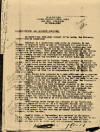
|
March 15, 1929.
"Memorandum for the American Legation,"
General Logan Feland, Managua, p. 1.
"In accordance with
your request of 14 March, the following
information is submitted: ¶ 1.
Pursuant to a conference held early in
January, it was decided to organize three
groups of Volunteers for operations in the
outlaw infested areas. Approximately three
hundred men were selected from a greater
number and the President selected three
Generals to lead them. These groups are
administered by the Guardia and operate in
combined operations under the tactical
control of the Commanding General and
subordinates designated by him. They are at
all times directed and assisted by our
forces which are always in close support.
¶ One group operated in Eastern
Segovia, another in Western Segovia and a
third in the area Northeast of Jinotega.
Recently the first two mentioned groups were
in Eastern Segovia and in conjunction with
our forces operated effectively in that
area. The third group after having operated
for some time in the Jinotega Area went to
the area Northeast of Yali and in
conjunction with our forces did very good
work. ¶ Those forces have
operated in a most efficient and aggressive
manner and have assisted materially in that
the ignorant people in the bandit areas have
been impressed with the fact and made to
realize that the United States is not
enforcing its will upon the Nicaraguan
people unsupported by any authority of this
country. ¶ Their services have
been extremely valuable in the outlaw
infested areas, principally because their
knowledge of the people, customs and country
has enabled them to detect and apprehend the
outlaw spies, agents and sympathizers of the
Sandino forces. ¶ Much good has
been done and it has afforded the Nicaraguan
Government an opportunity to assist in the
restoration of a more complete peace and
also it has afforded the Nicaragua
Government an opportunity for the expression
of its national sovereignty against her
enemies. ¶ Additionally those
forces and officers of the Nicaraguan
Government pursuant to an act of the
Congress furnish the agencies by which the
Nicaraguan Government is enabled to try
outlaws and their agents under Martial Law.
The Marine Forces have nothing to do with
this except to turn over any prisoners
together with the evidence, to the Guardia.
¶ 2. General Jiron, a Guatemalan, was
captured by the Marine Forces early in
February. He stated that he had quit and was
on his way out of the country. He also
stated that a number of other leaders and
men had, or would quit and subsequent events
tend to . . . "
|
|
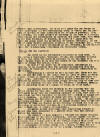
|
March 15, 1929.
"Memorandum for the American Legation,"
General Logan Feland, Managua, p. 2.
" . . . confirm that
information. He acted as a guide for our
forces in later operations and was
subsequently taken to Ocotal for the purpose
of getting as much information out of him as
possible. Late in February, and under
promise of clemency in the form of a parole,
providing he was instrumental in clearing
the Murra Area, with which he was very
familiar, of bandits, he acted as a guide
with the Volunteer group under the
leadership of General Escamilla. On the 6th
of March General Escamilla reported to the
President that after a trial by Court
Martial authorized by the President, he has
executed Jiron for treacherously misleading
the Nicaraguan Column. ¶ (NOTE:
For the Legation ¶ The above is
the information available in this case. It
was purely a Nicaraguan Government affair,
was conducted entirely by them, and Jiron
was executed pursuant to the sentence of a
Court Martial which acted upon the orders of
the President and with which my forces had
nothing to do. ¶ In view of the
above and if additional information is
desired, it is suggested that the Legation
communicate with the President of Nicaragua
who will have more complete information on
the subject. ¶ Additionally it
should be kept in mind that Jiron was the
one who led the raid on the Mining Area in
April of 1928, in which a great amount of
American and foreign property was destroyed
and taken away. According to reports from
police officials and our officers he robbed
many Nicaraguan people leaving many of them
destitute and starving and also made Mr.
Marshall a prisoner, keeping him in
captivity until as a result of which he
later died.) ¶ 3. Immediately
after the election it was apparent that the
outlaw morale was very low. They were poorly
clad, were having difficulty in getting the
necessary supplies of food, were short of
ammunition and were beginning to realize
that Sandino no longer had a real mission.
Statements of deserters were to the effect
that they realized the futility of
maintaining their cause. The so-called
patriotic motives of Sandino were no longer
evident even to the most ignorant of them
and whereas he had formerly obtained and
held his following by persuasive methods, he
had recently resorted to compulsory methods
and to threats of punishment. ¶
Intensive patrol operations were immediately
resumed or rather they were conducted on a
greater scale than was possible during the
election. ¶ The results to date
indicate a further and almost complete
disintegration of the outlaw structure.
Eastern Segovia and the area Northeast of
Yali have been completely cleaned out and
reports indicate that a large number of the
foreign bandits with their leaders have gone
out of this country and possibly have quit
entirely. It is considered extremely likely
that Sandino, fearing of his personal safety
has gone out of the country, whether
temporarily . . . "
|
|
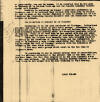
|
March 15, 1929.
"Memorandum for the American Legation,"
General Logan Feland, Managua, p. 3.
" . . . or
permanently, cannot be known. It is reported
that he has gone to Honduras or to British
Honduras and the reports incident thereto
appear well founded. ¶ Banditry
is certainly no longer a lucrative
profession in Nicaragua and it is believed
that outlaws have been made to realize it,
and as soon as the Guardia Nacional is able
to assume all of its functions the
Commanding General believes that the force
here may be materially reduced. ¶
The situation at present is as follows:
¶ Altamirano is in the area northeast
of Jinotega. Indications are that his band
has split up into small groups. Altamirano
is a real bandit and the Commanding General
does not believe that he has over concerned
himself greatly about the so-called
patriotic motives of Sandino. While it is
true that he has worked with him and under
him, he has done so more as a matter of
existence than anything else. ¶
Ortez and Salgado have recently been very
reliably reported as moving in the direction
of the Rio Negro and the information is such
as to indicate a very strong possibility
that they are attempting to reach the Gulf
of Fonseca, probably with the intention of
embarking for some other country. ¶
A few very small groups still exist in the
San Juan de Telpaneca area. ¶ In
conclusion it may be stated without fear of
contradiction, that the military situation
at the present time is the best that ir has
even been, and that this country is in the
most peaceful state it has ever enjoyed. The
Commanding General however desires to state
that there is and always will be some
banditry in this country. ¶
LOGAN FELAND"
|
|
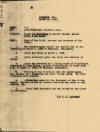
|
March 15, 1929.
"Trial and Execution of Bandit Leader,
Manuel Maria Jiron Ruano," Lt. H. H.
Hanneken, Oconguas. "1.
The subject-named bandit was turned over to
Gen. Escamilla on March 2, 1929 at Rempujon,
(Narauyal). ¶ 2. Jiron was tried
on March 2, 1929. ¶ 3. Above
enclosure gives the trial and sentence of
Jiron. ¶ 4. Jiron was executed
by a firing squad of Voluntarios, commanded
by Isaq Solano, Colonel Voluntarios, at
about 5:30 p.m. on March 2, 1929, at
Narauyal (Rempujon). ¶ 5.
Present at the execution were the
undersigned, Lt. Jordan, Gen. Escamilla and
above firing squad. No other witnesses were
present. ¶ 6. Jiron when asked
by the Commander of the firing squad,
whether or not he (Jiron) had anything final
to say, stated, No. ¶ 7. Jiron
died instantly and was buried at the place
of execution. ¶ /s/ H. H.
HANNEKEN"
|
|
_small.jpg)
|
March 21, 1929.
"Cumpleaños del
Director de Comunicaciones Gral. Caldera," La Tribuna
(Managua).
"Ayer celebró en
Chinandega su cumpleaños el Director General
de Comunicaciones
general Augusto J.
Caldera. Los empleados del ramo de que
es jefe le dirigieron calurosas
felicitaciones."
|
|
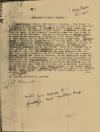
|
March 24, 1929.
"Statement of Manuel Matute" (English
translation only), Gen. Juan Escamilla, Las
Flores, District of Jinotega.
"Statement of Manuel
Matute. ¶ Reyes Romero lives at
the slope of Guapinol. This Romero is a
soldier of Pedro Altamirano. He is the spy
of the Coco River and the Picada of
Jinotega. At Santa Cruz he gets money loans
and provisions for the bandits of that
region. Altamirano’s trips are from the
Sedro [Los Cedros] to the ridges of
Bocaycito along the Tuma River in a valley
called Collolar [Coyolar]. The spy at
Bocaycito is Eduardo Picaco. He stays in the
mountains of Bocaycito for a few days and
when he sees patrols, he notifies the
bandits and joins them. Leocadio Garcia is
the spy at Sonpopera and on the Cua River,
the spies are Siferino Mendez and Jetrudes
Mercado. At the Guapinol, the spy is Sabas
Mazanares and a son of Santos Vasques, and
Toribio and Francilino Hernandez are at Las
Flores. There is a “Picada” at la Pita, and
it is said that Altamirano passed over the
ridge through Los Sedros [Los Cedros], and
that his family and two sons were with him,
and that they have a rendezvous in the
mountains of Pita and Bocaycito. Rosendo
Zelaya, who lives in Jinotega, is the
Sandinista agent who gets provisions in this
district, at Las Flores, for Altamirano. Sr.
Matute says that Ynes Rodriguez, who lives
at Los Sedros [Los Cedros], provides
Altamirano with supplies, and know where his
encampments are, and Mr. Matute also says
that while he was with Altamirano, he
assassinated the following: at Cua, Moises
Moreno; at Los Sedros [Los Cedros], Ramon
Mendez; at la “Kebrada” [La Quebrada],
Rosalio Rugama; and the edge of the Pantasma
Valley, Ramon Rugama. This is what Sr.
Matute stated on the 24th of March, 1929.
¶ Los Flores, District of Jinotega"
|
|
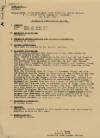
|
March 24, 1929.
"Battalion Intelligence Report," Capt. W. J.
Green, 3rd Battalion, 5th Regiment,
Matagalpa.
". . . E.
MILITARY OPERATIONS: ¶ The following patrols
were operating in this area during the
period covered by this report: ¶ Capt.
Arnett’s patrol operating in the Las Lajas
and Las Camelias areas. Lt. Fagans mounted
patrol operating in the Caratera area and
patrolling from Caratera to Paso Real De
Cua. Sgt. Sterns’ Algovia patrol operating
in the Isla-Cornubia, Dos Placeras, Uluse,
and Buena Vista areas. General Plata’s
patrol operating in the Yali area. ¶
Bandit Activities: ¶ 0518 The
following from Lt. Fagan at Caratera: Fairly
reliable information reports Pedron on other
side of the Pena Blanca in the area of La
Pavona, Paso Real De Cua with one hundred
men. 0522 The following from Co. San Rafael.
Native agent Concordia reports that enroute
Yali yesterday afternoon he encountered a
women (Luisa Herrera) and learned from her
that a group of bandits under Irias had sent
her from her home on northern slope of
ridge, place called Los Volcancitos less
than two leagues from Yali. Bandits told her
that they meant to fortify position and give
battle to marines they believed following.
0523 The following from Co. San Rafael: One
hundred and fifty bandits raided the finca
of Andis Bresuis three leagues from
Concordia at 2300 last night. Bandits led by
Diaz Blandon and Irias took horses, mules
and clothing and left finca completely
wrecked. All were well armed. . . . "
|
|
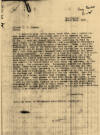
|
March 26, 1929.
Letter from Gen. Juan Escamilla, Las Flores,
to Col. R. H. Dunlap, Ocotal (English
translation only).
"I received your
letter dated March 23rd, and I answer you
with great pleasure, and I will give you an
account of the prisoners that I have taken,
for being implicated in banditry at Cua. I
took Sr. Manuel Matute who, according to
what he says, works in Los Sedros [Los
Cedros] and according to statements made by
him, was a soldier under Altamirano. Today I
gave the Lieutenant a copy of the statement
made by him so that he may send it to you at
Ocotal and I sent him another one in
Spanish, and I will tell you what happened
when we arrived at the house of Julio
Guatemala. The report of a bomb was heard,
to the south. I immediately ordered a detail
of Voluntarios out, and in ten minutes the
detail came back with two men and four women
who were found hiding at the mountain in
some enormous caves, but the Jefe of the
detail tells me that three men ran away, up
the mountain. The prisoners are: Concepcion
Herrera and Esteban Perez. They would not
give the names of the men who ran away. They
say that Julio Guatemala is in Jinotega, but
this man is in the camp of Altamirano, and
is in contact with him, and goes to Jinotega
and brings information for the bandits. Upon
the burning of a house, another bomb
exploded. It was in the roof of the house.
Some pieces of fuse were found for bombs. I
have confined Concepcion Herrera in these
barracks and Esteban Perez I left at his
house, because he has rheumatism and cannot
walk. The women have been left in their
homes. I am not disturbing anyone but
Herrera who is confined. I salute you most
affectionately. I am always at your service.
¶ J. Escamilla. ¶ P.S. My
troop of Volunteers respectfully greets
you."
|
|
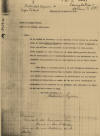
|
Marzo 26 de 1929.
Sr. Natividad Espinosa, Managua, al Excmo.
Sr. Logan Feland, Jefe de las Fuerzas
Americanas (original).
"Señor: ¶
En la ciudad de Jinotega y en las carceles
de esa ciudad se encuentra preso el jóven
Alfonso Torres, por atribuirsele el haber
acompañado a otros que militan o han
militado en las fuerzas del Gral. Sandino.
Puedo asegurar al señor Feland que el joven
Torres, sobrino mio, hace mas de siete meses
que se encontraba alejado de ese movimiento
con el propósito de no mezclarse mas en esos
asuntos, y eso es facil comprobarlo. ¶
Como ahora se encuentra preso y ha sido
duramente maltratado por las fuerzas
expedicionarias, vento a rogaros ordeneis
sea trasladado a esta capital donde pueda
permanecer en prision, pero con las debidas
garantias. Os hablo, señor, en nombre de los
mas altos senetimientos de humanidad y en
las seguridad de que pondreis toda atencion
a la súplica que con todo respeto os hago.
¶ Con toda atencion s.s. ¶
[signed] Natividad Espinosa"
|
|

|
March 27, 1929.
Jefe Expedicionario Felipe F. Flores, Los
Calpules, Honduran border, to President José
María Moncada, Managua (English translation
only).
"Yesterday General
Juan B. Mendez, Expeditionary Commander of
Honduras, sent Colonel Abel Balladares to
confer with the bandit Carlos Salgado who is
at Los Calpules, in Nicaraguan territory.
The conference having taken place, Salgado
stated that within eight days he would
decide whether or not he will give up, as he
has to consult his comrades first: Colonel
Balladares told him that General Mendoza
would not permit him to enter Honduran
territory, and that he would defeat any
attempt to get in (Honduras). ¶
I saw General Mendoza today at Los Calpules,
at 10:20 am and he informed me that Salgado
had left at 11:30 pm yesterday, which
information was obtained through his spy
system, and the news was satisfactory to me,
since I see the interest which he is taking
in cooperating with us, in order that this
frontier may be pacified. I have captured
some of the bandits’ accomplices, and I am
trying to find their rendezvous, so as to
defeat them. I will let you know as to the
result. ¶ Your affectionate
subordinate, ¶ Felipe F. Flores.
Jefe Expedicionario."
|
|

|
March 29, 1929.
Telegram from Jefe Expedicionario Felipe F.
Flores, frontier on outskirts of
Pedragalito, to President Gen. José María
Moncada, Managua (English translation only).
"Frontier on outskirts
of Pedragalito. 29 March, 1929 9:00 a.m.
¶ Mr. President, Gen. Jose Maria
Moncada, Managua. ¶ I arrived
here at 8:00 a.m. behind some bandits, and
according to information they passed through
here at 2:00 p.m. yesterday going in
direction of Las Manos. I continue in
pursuit of them. I have information that a
Honduran force has left Yuscaran to look
after this border and to prevent the bandits
from crossing into Honduran territory.
¶ Your affectionate subaltern, ¶
FELIPE F. FLORES Expeditionary Chief.
¶ Jose J. Espinosa Secretary. ¶
To Colonel Dunlap for his information and
further transmission to the President of
Nicaragua. ¶ J. J. Espinosa
Sec’y."
|
|

|
March 31, 1929.
"Report of Patrol," Lt. H. H. Hanneken, La
Flor, Jinotega, p. 1.
"1. Lt. Hanneken, Gen.
Escaumilla, 10 Marines, 20 Voluntarios and a
prisoner Conception Herrera cleared La Flor
at 0700 to patrol area around La Flor to
investigate various persons living in area.
Upon arriving about 3 miles S.E. from La
Flor found a large champa and one small one
occupied by 3 women and children and one
man, none of them attempted to [flee?] saw
us about 200 yds away. The man Transito
Vasquez stated that Altimarano had passed
about 1/2 mile away from this place about 15
days previously and had gone to the house of
Jose Garcia for the purpose of killing Jose
Garcia and that a Vasquez had also taken to
the brush because Altimarano would also kill
him. Took Vasquez along to show us the
trails in area. Arrived at Jose Garcia’s
finca about a mile away and about 4 miles
S.E. of La Flor and found Senora Garcia at
the house with three small children, stating
her husband was in the woods. She blew a
horn and said her husband would show up
directly. Mrs. Garcia stated that Altimarano
had camped at her finca about 15 days ago
and remained for 24 hours waiting for Jose
Garcia to make an appearance with intentions
of killing him, but Jose did not appear, so
Altamarno’s band left taking trail toward
Boraicito. About 3 days later Capt. Edson
arrived at her house and remained about 5
minutes. Altamarno while there killed a beef
and a hog. That he had about 40 men and that
she knew about 4 of them. . . . "
|
|
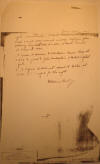
|
March 31, 1929.
"Report of Patrol," Lt. H. H. Hanneken, La
Flor, Jinotega, p. 2. "[first
line missing] . . . reports, attached
hereto. Cleared Garcia finca and about 400
yds. away received message drop from plane
containing Brig. Field Order #1 dated 28
March. Arrived at Base at 1400. ¶
2. Lt. Jordan 10 Marines, 20 Voluntarios
cleared Base at 0730 to patrol to Julio
Guatemala’s. Attached is patrol report.
¶ 3. Lt. Piper’s Detachment arrived at
La Flor at 1530 and camped for the night.
¶ H. Hanneken"
|
|
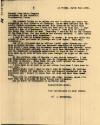
|
March 31, 1929.
Jefe Expedicionario Juan Escamilla, La
Pavona, to President General José María
Moncada, Managua (English translation only).
"The
present letter is to salute you and to
advise you about the expedition in this
district of Jinotega. As we were advised
that the bandit Pedron Altamirano was around
this district we turned back towards this
district, but I have not been able to find
him. I captured six men of Altamirano’s, but
I haven’t been able to locate him where they
thought he was. Yesterday I went as far as
the borders of the Tuma River, but the
bandits had already retired. I have listed
all the people going with Altamirano.
¶ I sent a list to Colonel Dunlap, in
Ocotal, to have him order the arrest of some
gentlemen of Jinotega who live there. They
help Altamirano. ¶ One of my
prisoners was an officer (jefe) under
Altamirano; his name is Manuel Matute. That
man declared something of importance from
which I have drawn out documents
compromising some persons, about whom I have
already advised, so as to have them captured
in order to end the Sandinist propaganda
established by them in the villages. I have
made up my mind to have this zone tranquil
in eight or ten more days. ¶ At
the northern zone of Segovia it was almost
tranquil. I had 162 Sandinistas surrender in
San Juan de Telpaneca and about thirty and
some in Quilali. Some forty who are still
around the Jalapa district are still to be
taken care of. ¶ I have made up
my mind to go and subdue them when I turn
back to that zone. ¶ Within
eight days I want to start over El Balsamo,
El Varillal and Cerro Blanco for they have a
few cantonments thereabout in the mountains
and I expect to chase them out soon and have
them tamed down. ¶ Soon I’ll be
informing you about the other journey, which
I’ll take over the mountains of Cerro Blanco
and Telpaneca. ¶ Respectfully
yours, ¶ Your subordinate at
your orders, ¶ (s) J. ESCAMILLA."
|
|
|
|
|
End of Page 1.
|
|
|
|
|
|
|
|
|
|
TOP OF PAGE
|
|
|
|

